c4679bb5e08816aec2958558a0c1f11e.ppt
- Количество слайдов: 120
 Overview of Health IT Certification Certified Professional in Electronic Health Records and Certified Professional in Health Information Technology By: Margret Amatayakul, MBA, RHIA, CHPS, CPEHR, CPHIT, FHIMSS Steven S. Lazarus, Ph. D, CPEHR, CPHIT, FHIMSS The HIT Summit West March 6, 2005 1
Overview of Health IT Certification Certified Professional in Electronic Health Records and Certified Professional in Health Information Technology By: Margret Amatayakul, MBA, RHIA, CHPS, CPEHR, CPHIT, FHIMSS Steven S. Lazarus, Ph. D, CPEHR, CPHIT, FHIMSS The HIT Summit West March 6, 2005 1
 About Health IT Certification • EHR and HIT training for professionals – Regional hotel programs – In-house programs – Online programs • Certification for professionals • www. healthitcertificationcom 2 Copyright © 2005
About Health IT Certification • EHR and HIT training for professionals – Regional hotel programs – In-house programs – Online programs • Certification for professionals • www. healthitcertificationcom 2 Copyright © 2005
 Margret A • MargretA Consulting, LLC • Strategies for the digital future of healthcare information • • • Information management and systems consultant, focusing on electronic health records and their value proposition Adjunct faculty, College of St. Scholastica; former positions with CPRI, AHIMA, Univ. of Ill. , IEEI • Active participant in standards development • Speaker and author (Silver ASHPE Awards for “HIPAA on the Job” column in Journal of AHIMA) • • Strategic IT planning Compliance assessments Work flow redesign Project management and oversight ROI/benefits realization Training and education Vendor selection Product/ market analysis 3 Copyright © 2005
Margret A • MargretA Consulting, LLC • Strategies for the digital future of healthcare information • • • Information management and systems consultant, focusing on electronic health records and their value proposition Adjunct faculty, College of St. Scholastica; former positions with CPRI, AHIMA, Univ. of Ill. , IEEI • Active participant in standards development • Speaker and author (Silver ASHPE Awards for “HIPAA on the Job” column in Journal of AHIMA) • • Strategic IT planning Compliance assessments Work flow redesign Project management and oversight ROI/benefits realization Training and education Vendor selection Product/ market analysis 3 Copyright © 2005
 Steve Lazarus. Boundary Information Group Strategies for workflow, productivity, quality and patient satisfaction improvement through health care information • • • Business process consultant focusing on electronic health records, and electronic transactions between organizations Former positions with MGMA, University of Denver, Dartmouth College Active leader in the Workgroup for Electronic Data Interchange (WEDI) Speaker and author (two books on HIPAA Security and one forthcoming on electronic health record) Co-Founder of Health IT Certification • Strategic IT business process planning • ROI/benefits realization • Project management and oversight • Workflow redesign • Education and training • Vendor selection and enhanced use of vendor products • Facilitate collaborations among organizations to share/exchange health care information 4 Copyright © 2005
Steve Lazarus. Boundary Information Group Strategies for workflow, productivity, quality and patient satisfaction improvement through health care information • • • Business process consultant focusing on electronic health records, and electronic transactions between organizations Former positions with MGMA, University of Denver, Dartmouth College Active leader in the Workgroup for Electronic Data Interchange (WEDI) Speaker and author (two books on HIPAA Security and one forthcoming on electronic health record) Co-Founder of Health IT Certification • Strategic IT business process planning • ROI/benefits realization • Project management and oversight • Workflow redesign • Education and training • Vendor selection and enhanced use of vendor products • Facilitate collaborations among organizations to share/exchange health care information 4 Copyright © 2005
 Health IT Certification Faculty • Margret Amatayakul, MBA, RHIA, CHPS, FHIMSS • Bill Braithwaite, MD, Ph. D • Ted Cooper, MD • Steven S. Lazarus, Ph. D, FHIMSS • Rosemarie Nelson, MS • Paul T. Smith, Esq. • Adele A. Waller, Esq. 5 Copyright © 2005
Health IT Certification Faculty • Margret Amatayakul, MBA, RHIA, CHPS, FHIMSS • Bill Braithwaite, MD, Ph. D • Ted Cooper, MD • Steven S. Lazarus, Ph. D, FHIMSS • Rosemarie Nelson, MS • Paul T. Smith, Esq. • Adele A. Waller, Esq. 5 Copyright © 2005
 Health IT Certification Advisory Board • • Mark R. Anderson, CPHIMS, FHIMSS W. Holt Anderson Garry Carneal, MA, JD Peter N. Grant, JD, Ph. D John D. Halamka, MS, MD John Iglehart William F. Jessee, MD, ACMPE Ronald B. Kuppersmith, MD, MBA, FACS 6 Copyright © 2005
Health IT Certification Advisory Board • • Mark R. Anderson, CPHIMS, FHIMSS W. Holt Anderson Garry Carneal, MA, JD Peter N. Grant, JD, Ph. D John D. Halamka, MS, MD John Iglehart William F. Jessee, MD, ACMPE Ronald B. Kuppersmith, MD, MBA, FACS 6 Copyright © 2005
 Health IT Certification Advisory Board • • Janet Marchibroda Blackford Middleton, MD, MPH, MSc Ian Morrison, Ph. D Lawrence Pawola, Pharm. D, MBA Jeff Rideout, MD, MA Dennis J. Streveler, Ph. D L. Carl Volpe 7 Copyright © 2005
Health IT Certification Advisory Board • • Janet Marchibroda Blackford Middleton, MD, MPH, MSc Ian Morrison, Ph. D Lawrence Pawola, Pharm. D, MBA Jeff Rideout, MD, MA Dennis J. Streveler, Ph. D L. Carl Volpe 7 Copyright © 2005
 EHR/HIT Courses • • • I. III. IV. V. VIII. IX. X. Overview of HIT Principles of EHR Migration Path Planning for EHR Legal and Regulatory Aspects Managing EHR ROI EHR Systems Selection EHR Implementation Support CPOE and E-Prescribing Emerging HIT Infrastructure 8 Copyright © 2005
EHR/HIT Courses • • • I. III. IV. V. VIII. IX. X. Overview of HIT Principles of EHR Migration Path Planning for EHR Legal and Regulatory Aspects Managing EHR ROI EHR Systems Selection EHR Implementation Support CPOE and E-Prescribing Emerging HIT Infrastructure 8 Copyright © 2005
 Agenda 1. IX. CPOE and e-prescribing 2. X. Emerging HIT infrastructure 9 Copyright © 2005
Agenda 1. IX. CPOE and e-prescribing 2. X. Emerging HIT infrastructure 9 Copyright © 2005
 IX. CPOE and E-Prescribing 10 Copyright © 2005
IX. CPOE and E-Prescribing 10 Copyright © 2005
 Objectives • Upon completion of this course, participants will be able to: – Identify the importance of CPOE and e-prescribing for patient safety. – Establish the contexts in which CPOE and eprescribing are implemented. – Describe the cooperation, coordination, and connectivity required to overcome challenges and achieve meaningful CPOE and e-prescribing. – Discuss electronic medication administration and pharmacy support systems that complement CPOE and e-prescribing. – Identify and prepare to continuously monitor national initiatives. 11 Copyright © 2005
Objectives • Upon completion of this course, participants will be able to: – Identify the importance of CPOE and e-prescribing for patient safety. – Establish the contexts in which CPOE and eprescribing are implemented. – Describe the cooperation, coordination, and connectivity required to overcome challenges and achieve meaningful CPOE and e-prescribing. – Discuss electronic medication administration and pharmacy support systems that complement CPOE and e-prescribing. – Identify and prepare to continuously monitor national initiatives. 11 Copyright © 2005
 Topics Part 1. Patient Safety Part 2. Context of CPOE and E-Prescribing within Health Information Technology Part 3. Challenges in CPOE and EPrescribing Part 4. National Initiatives 12 Copyright © 2005
Topics Part 1. Patient Safety Part 2. Context of CPOE and E-Prescribing within Health Information Technology Part 3. Challenges in CPOE and EPrescribing Part 4. National Initiatives 12 Copyright © 2005
 IX. CPOE and E-Prescribing Part 1. Patient Safety 13 Copyright © 2005
IX. CPOE and E-Prescribing Part 1. Patient Safety 13 Copyright © 2005
 Content Part 1. • • • The Driving Factor IOM Recommendations Subsequent Actions on Patient Safety Elements Non-Medication Errors Medication Use Processes Contributing to Errors • Cost of Errors • Public Perceptions 14 Copyright © 2005
Content Part 1. • • • The Driving Factor IOM Recommendations Subsequent Actions on Patient Safety Elements Non-Medication Errors Medication Use Processes Contributing to Errors • Cost of Errors • Public Perceptions 14 Copyright © 2005
 The Driving Factor 15 Copyright © 2005
The Driving Factor 15 Copyright © 2005
 IOM Recommendations • • Fragmentation Reimbursement Liability Accreditation Build a Safer System 16 Copyright © 2005
IOM Recommendations • • Fragmentation Reimbursement Liability Accreditation Build a Safer System 16 Copyright © 2005
 IOM Recommended Approaches • National focus • Learn from errors/reporting • Raising standards • Safety systems in healthcare organizations 17 Copyright © 2005
IOM Recommended Approaches • National focus • Learn from errors/reporting • Raising standards • Safety systems in healthcare organizations 17 Copyright © 2005
 18 Copyright © 2005
18 Copyright © 2005
 19 Copyright © 2005
19 Copyright © 2005
 20 Copyright © 2005
20 Copyright © 2005
 Patient Safety Elements Medication Errors Near Misses ADE Reactions not related to error (ADR) 21 Copyright © 2005
Patient Safety Elements Medication Errors Near Misses ADE Reactions not related to error (ADR) 21 Copyright © 2005
 Medication Error • “The failure of a planned action to be completed as intended (i. e. , error of execution) or the use of a wrong plan to achieve an aim (i. e. , error of planning). ” – To Err Is Human 22 Copyright © 2005
Medication Error • “The failure of a planned action to be completed as intended (i. e. , error of execution) or the use of a wrong plan to achieve an aim (i. e. , error of planning). ” – To Err Is Human 22 Copyright © 2005
 Adverse Drug Event • “An injury caused by medical management rather than by the underlying disease or condition of the patient. ” – To Err Is Human • AS DISTINGUISHED FROM: – Adverse drug reaction, that is unanticipated and generally not preventable – Side effect, which is known (and often expected) 23 Copyright © 2005
Adverse Drug Event • “An injury caused by medical management rather than by the underlying disease or condition of the patient. ” – To Err Is Human • AS DISTINGUISHED FROM: – Adverse drug reaction, that is unanticipated and generally not preventable – Side effect, which is known (and often expected) 23 Copyright © 2005
 Non-Medication Errors • • • • Diagnostic: Error or delay in diagnosis Failure to employ indicated tests Use of outmoded tests or therapy; not using documented “best practices” Failure to act on results of monitoring or testing Treatment: Error in performance of an operation, procedure, or test Error in administering treatment Avoidable delay in treatment or in responding to abnormal test Inappropriate (not indicated) care Preventive: Failure to provide prophylactic treatment when appropriate Inadequate monitoring or follow-up of treatment Other: Failure of communication Equipment failure 24 Copyright © 2005
Non-Medication Errors • • • • Diagnostic: Error or delay in diagnosis Failure to employ indicated tests Use of outmoded tests or therapy; not using documented “best practices” Failure to act on results of monitoring or testing Treatment: Error in performance of an operation, procedure, or test Error in administering treatment Avoidable delay in treatment or in responding to abnormal test Inappropriate (not indicated) care Preventive: Failure to provide prophylactic treatment when appropriate Inadequate monitoring or follow-up of treatment Other: Failure of communication Equipment failure 24 Copyright © 2005
 Medication Use Processes Contributing to Errors • • • • • Prescribing: Assessing the need for and selecting the correct drug Individualizing therapeutic regimen and designating the desired therapeutic response Communicating expectations to the patient Dispensing: Reviewing and process the order Compounding and preparing the drug Dispensing the drug in a timely manner Administering: Administering the right medication to the right patient when indicated Informing the patient about the medication and including the patient in administration Monitoring: Monitoring and documenting patient’s response Identifying and reporting adverse drug events Reevaluating drug selection, regimen, frequency, and duration Systems and Management Control: Collaborating and communicating among caregivers Reviewing and managing patient’s complete therapeutic drug regimen 25 Copyright © 2005
Medication Use Processes Contributing to Errors • • • • • Prescribing: Assessing the need for and selecting the correct drug Individualizing therapeutic regimen and designating the desired therapeutic response Communicating expectations to the patient Dispensing: Reviewing and process the order Compounding and preparing the drug Dispensing the drug in a timely manner Administering: Administering the right medication to the right patient when indicated Informing the patient about the medication and including the patient in administration Monitoring: Monitoring and documenting patient’s response Identifying and reporting adverse drug events Reevaluating drug selection, regimen, frequency, and duration Systems and Management Control: Collaborating and communicating among caregivers Reviewing and managing patient’s complete therapeutic drug regimen 25 Copyright © 2005
 Preventing Medication Errors Common Factors in Medication Errors: • Decline in renal or hepatic function requiring alteration of drug therapy • Patient history of allergy to the same medication class • Using the wrong drug name, dosage form, or abbreviation • Incorrect dosage calculations • Atypical or unusual and critical dosage frequency considerations • Incomplete orders/prescriptions and illegible handwriting Process Improvement Efforts to Reduce Errors: • Knowledge and the application of knowledge regarding drug therapy • Knowledge and use of knowledge regarding patient factors that affect drug therapy • Use of calculations, decimal points, or unit and rate expression factors • Nomenclature, for example, incorrect drug name, dosage form, or abbreviations 26 Copyright © 2005
Preventing Medication Errors Common Factors in Medication Errors: • Decline in renal or hepatic function requiring alteration of drug therapy • Patient history of allergy to the same medication class • Using the wrong drug name, dosage form, or abbreviation • Incorrect dosage calculations • Atypical or unusual and critical dosage frequency considerations • Incomplete orders/prescriptions and illegible handwriting Process Improvement Efforts to Reduce Errors: • Knowledge and the application of knowledge regarding drug therapy • Knowledge and use of knowledge regarding patient factors that affect drug therapy • Use of calculations, decimal points, or unit and rate expression factors • Nomenclature, for example, incorrect drug name, dosage form, or abbreviations 26 Copyright © 2005
 Cost of Errors 0 0 , 0 2 27 Copyright © 2005
Cost of Errors 0 0 , 0 2 27 Copyright © 2005
 Public Perceptions Qualifications of Professionals 15% 28 Copyright © 2005
Public Perceptions Qualifications of Professionals 15% 28 Copyright © 2005
 IX. CPOE and E-Prescribing Part 2. Context of CPOE and EPrescribing in HIT 29 Copyright © 2005
IX. CPOE and E-Prescribing Part 2. Context of CPOE and EPrescribing in HIT 29 Copyright © 2005
 Content Part 2. • • • Scope of HIT Addressing Medication Errors Current Medication Ordering Process Medication Error Improvement through HIT CPOE vs. E-Prescribing Defined Prescription Transactions Levels of E-Prescribing Adoption Rates E-Prescribing Stakeholders E-Prescribing Cost Savings E-Prescribing Incentives 30 Copyright © 2005
Content Part 2. • • • Scope of HIT Addressing Medication Errors Current Medication Ordering Process Medication Error Improvement through HIT CPOE vs. E-Prescribing Defined Prescription Transactions Levels of E-Prescribing Adoption Rates E-Prescribing Stakeholders E-Prescribing Cost Savings E-Prescribing Incentives 30 Copyright © 2005
 Scope of HIT Addressing Medication Errors • • Laboratory information system (LIS) Clinical decision support (CDS) Alerts engine Computerized provider order entry (CPOE) Pharmacy information system (PIS) Automated dispensing devices (Rx) Nursing information system (NIS) Bar-code medication administration record (MAR) 31 Copyright © 2005
Scope of HIT Addressing Medication Errors • • Laboratory information system (LIS) Clinical decision support (CDS) Alerts engine Computerized provider order entry (CPOE) Pharmacy information system (PIS) Automated dispensing devices (Rx) Nursing information system (NIS) Bar-code medication administration record (MAR) 31 Copyright © 2005
 Pharmacy Benefits Manager A PBM adjudicates prescription drug claims, establishes formularies, tracks physician prescribing patterns, provides education to improve efficiency and cost effectiveness, and contributes information in support of disease management programs. 32 Copyright © 2005
Pharmacy Benefits Manager A PBM adjudicates prescription drug claims, establishes formularies, tracks physician prescribing patterns, provides education to improve efficiency and cost effectiveness, and contributes information in support of disease management programs. 32 Copyright © 2005
 Current Medication Process Medical and Medication History Physical Exam and Diagnosis Indications/ Contraindications Medication Order (50%) Formulary Inventory Medication Transcription (10%) Pharmacy Evaluation (15%) Staff Education Selection Preparation Distribution Medication Administration (25%) Primary points of error and % contributing Estimates of error from Bates et al. Incidence of adverse drug events in hospitalized patients. JAMA 1995; 274: 29 -34 Copyright © 2005 Monitoring and Intervention Error and ADE Reporting 33
Current Medication Process Medical and Medication History Physical Exam and Diagnosis Indications/ Contraindications Medication Order (50%) Formulary Inventory Medication Transcription (10%) Pharmacy Evaluation (15%) Staff Education Selection Preparation Distribution Medication Administration (25%) Primary points of error and % contributing Estimates of error from Bates et al. Incidence of adverse drug events in hospitalized patients. JAMA 1995; 274: 29 -34 Copyright © 2005 Monitoring and Intervention Error and ADE Reporting 33
 Medication Management EHR LIS Medical History PHR Medication History PBM Consolidator CDS Indications/ Contraindications Alerts CPOE DKB Used with permission, MargretA Consulting, LLC 34 Copyright © 2005
Medication Management EHR LIS Medical History PHR Medication History PBM Consolidator CDS Indications/ Contraindications Alerts CPOE DKB Used with permission, MargretA Consulting, LLC 34 Copyright © 2005
 CPOE Medication Order (50%) Medication Transcription (10%) 35 Copyright © 2005
CPOE Medication Order (50%) Medication Transcription (10%) 35 Copyright © 2005
 Pharmacy Management PIS PBM Consolidator Supply Chain LIS Formulary Pharmacy Evaluation (15%) DKB Inventory Selection Preparation Distribution Used with permission, MargretA Consulting, LLC 36 Copyright © 2005
Pharmacy Management PIS PBM Consolidator Supply Chain LIS Formulary Pharmacy Evaluation (15%) DKB Inventory Selection Preparation Distribution Used with permission, MargretA Consulting, LLC 36 Copyright © 2005
 HIT for Medication Management Charge Capture Staff Education Medication Administration (25%) Monitoring and Intervention EHR Error and ADE Reporting Used with permission, MargretA Consulting, LLC 37 Copyright © 2005
HIT for Medication Management Charge Capture Staff Education Medication Administration (25%) Monitoring and Intervention EHR Error and ADE Reporting Used with permission, MargretA Consulting, LLC 37 Copyright © 2005
 Five Rights Medication Administration • Right patient • Right drug • Right time • Right dose • Right route Institute for Safe Medication Practices 38 Copyright © 2005
Five Rights Medication Administration • Right patient • Right drug • Right time • Right dose • Right route Institute for Safe Medication Practices 38 Copyright © 2005
 CPOE vs. E-Prescribing Hospital Provider E-Prescribing Provider CPOE Discharge ED Outpatient Institutional Pharmacy Used with permission, MargretA Consulting, LLC Retail/ Ambulatory Pharmacy 39 Copyright © 2005
CPOE vs. E-Prescribing Hospital Provider E-Prescribing Provider CPOE Discharge ED Outpatient Institutional Pharmacy Used with permission, MargretA Consulting, LLC Retail/ Ambulatory Pharmacy 39 Copyright © 2005
 E-Prescribing Definition 40 Copyright © 2005
E-Prescribing Definition 40 Copyright © 2005
 Prescription Transactions Prescriber Dispenser New Script Change Cancel Request for Prior Auth Fill Status Refill Renewal Used with permission, MargretA Consulting, LLC 41 Copyright © 2005
Prescription Transactions Prescriber Dispenser New Script Change Cancel Request for Prior Auth Fill Status Refill Renewal Used with permission, MargretA Consulting, LLC 41 Copyright © 2005
 New Prescriptions/Changes • New ‘script written by prescriber (physician or other authorized provider) • Script reviewed by dispenser (pharmacist) and potential changes recommended: – Indications for different drug – Contraindications – Cost 42 Copyright © 2005
New Prescriptions/Changes • New ‘script written by prescriber (physician or other authorized provider) • Script reviewed by dispenser (pharmacist) and potential changes recommended: – Indications for different drug – Contraindications – Cost 42 Copyright © 2005
 Other Transactions • Prior authorization • Cancel • Fill status notification 43 Copyright © 2005
Other Transactions • Prior authorization • Cancel • Fill status notification 43 Copyright © 2005
 Refill/Renewal Refill = original prescription may be filled again Renewal = issuing the same prescription again 44 Copyright © 2005
Refill/Renewal Refill = original prescription may be filled again Renewal = issuing the same prescription again 44 Copyright © 2005
 E-Prescribing Systems 6. Integration with EHR 5. Connectivity: MDs office, pharmacy, PBM and intermediaries 4. Medication Management: Prior medications are available for renewal, interaction checks, etc. 3. Supporting patient data is included: Demographics, allergy, formulary, and/or payer information 2. Standalone Prescription Writer: Search by drug name and create prescription; no long-term data about patient accessible 1. Basic electronic reference only: Drug information, dosing 2. calculators, formulary information available, but not automatically shown 45 Copyright © 2005 Source: e. Health Initiative, Electronic Prescribing: Toward Maximum Value and Rapid Adoption, April 14, 2004
E-Prescribing Systems 6. Integration with EHR 5. Connectivity: MDs office, pharmacy, PBM and intermediaries 4. Medication Management: Prior medications are available for renewal, interaction checks, etc. 3. Supporting patient data is included: Demographics, allergy, formulary, and/or payer information 2. Standalone Prescription Writer: Search by drug name and create prescription; no long-term data about patient accessible 1. Basic electronic reference only: Drug information, dosing 2. calculators, formulary information available, but not automatically shown 45 Copyright © 2005 Source: e. Health Initiative, Electronic Prescribing: Toward Maximum Value and Rapid Adoption, April 14, 2004
 Levels of E-Prescribing 1. 2. 3. 4. 5. 6. Electronic prescription reference Standalone prescription writer Patient-specific prescription creation These systems must be Medication management kept up-to-date. Reliance on Connectivity out-of-date information Integration with EHR may be even more harmful 46 Copyright © 2005
Levels of E-Prescribing 1. 2. 3. 4. 5. 6. Electronic prescription reference Standalone prescription writer Patient-specific prescription creation These systems must be Medication management kept up-to-date. Reliance on Connectivity out-of-date information Integration with EHR may be even more harmful 46 Copyright © 2005
 E-Prescribing Adoption Rates 47 Copyright © 2005
E-Prescribing Adoption Rates 47 Copyright © 2005
 E-Prescribing Stakeholders • • Patients Prescribers Dispensers Health plans More than 3 billion prescriptions are written annually in the U. S. , and used by 65 percent of all persons in the U. S. Some estimate that with telephone tag and refills, the percent of calls between prescribers and dispensers is actually 30 to 40 percent of all prescriptions written. 48 Copyright © 2005
E-Prescribing Stakeholders • • Patients Prescribers Dispensers Health plans More than 3 billion prescriptions are written annually in the U. S. , and used by 65 percent of all persons in the U. S. Some estimate that with telephone tag and refills, the percent of calls between prescribers and dispensers is actually 30 to 40 percent of all prescriptions written. 48 Copyright © 2005
 Cost-Savings and Incentives Providers get: • Reduced risk • Reduced hassles (primarily for staff and patients) 49 Copyright © 2005
Cost-Savings and Incentives Providers get: • Reduced risk • Reduced hassles (primarily for staff and patients) 49 Copyright © 2005
 IX. CPOE and E-Prescribing Part 3. Challenges in CPOE and E-Prescribing 50 Copyright © 2005
IX. CPOE and E-Prescribing Part 3. Challenges in CPOE and E-Prescribing 50 Copyright © 2005
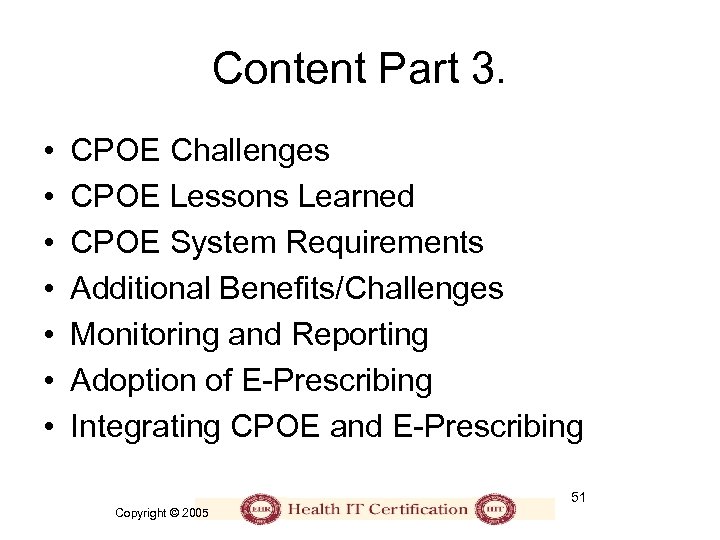 Content Part 3. • • CPOE Challenges CPOE Lessons Learned CPOE System Requirements Additional Benefits/Challenges Monitoring and Reporting Adoption of E-Prescribing Integrating CPOE and E-Prescribing 51 Copyright © 2005
Content Part 3. • • CPOE Challenges CPOE Lessons Learned CPOE System Requirements Additional Benefits/Challenges Monitoring and Reporting Adoption of E-Prescribing Integrating CPOE and E-Prescribing 51 Copyright © 2005
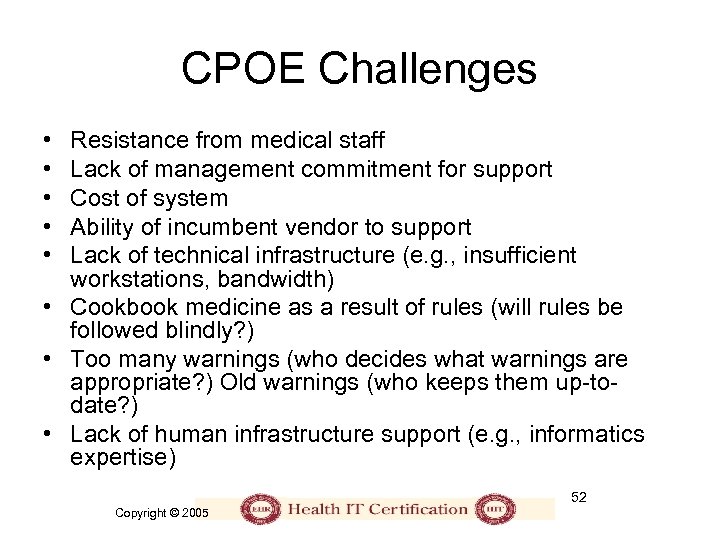 CPOE Challenges • • • Resistance from medical staff Lack of management commitment for support Cost of system Ability of incumbent vendor to support Lack of technical infrastructure (e. g. , insufficient workstations, bandwidth) • Cookbook medicine as a result of rules (will rules be followed blindly? ) • Too many warnings (who decides what warnings are appropriate? ) Old warnings (who keeps them up-todate? ) • Lack of human infrastructure support (e. g. , informatics expertise) 52 Copyright © 2005
CPOE Challenges • • • Resistance from medical staff Lack of management commitment for support Cost of system Ability of incumbent vendor to support Lack of technical infrastructure (e. g. , insufficient workstations, bandwidth) • Cookbook medicine as a result of rules (will rules be followed blindly? ) • Too many warnings (who decides what warnings are appropriate? ) Old warnings (who keeps them up-todate? ) • Lack of human infrastructure support (e. g. , informatics expertise) 52 Copyright © 2005
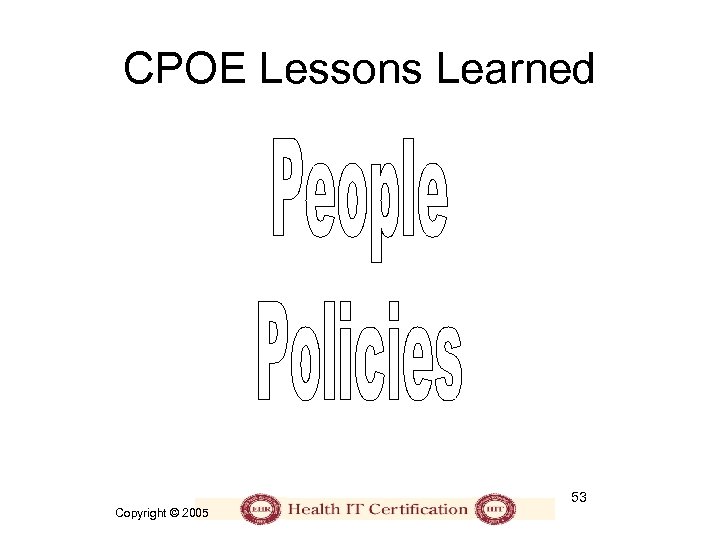 CPOE Lessons Learned 53 Copyright © 2005
CPOE Lessons Learned 53 Copyright © 2005
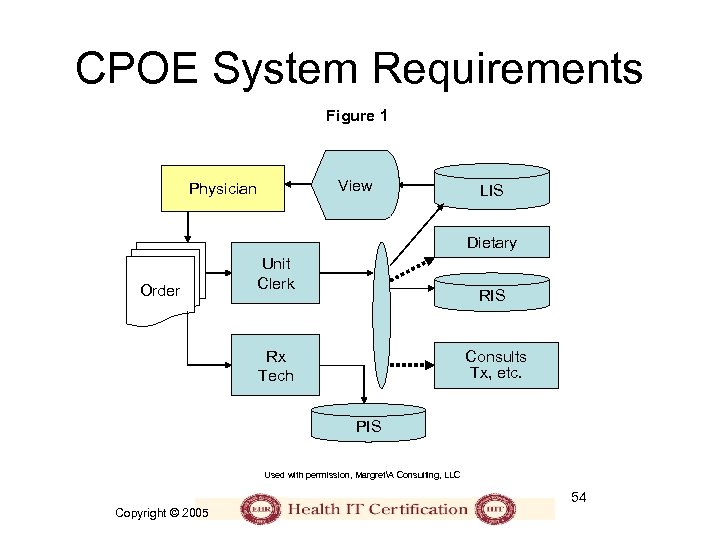 CPOE System Requirements Figure 1 View Physician LIS Dietary Order Unit Clerk RIS Rx Tech Consults Tx, etc. PIS Used with permission, MargretA Consulting, LLC 54 Copyright © 2005
CPOE System Requirements Figure 1 View Physician LIS Dietary Order Unit Clerk RIS Rx Tech Consults Tx, etc. PIS Used with permission, MargretA Consulting, LLC 54 Copyright © 2005
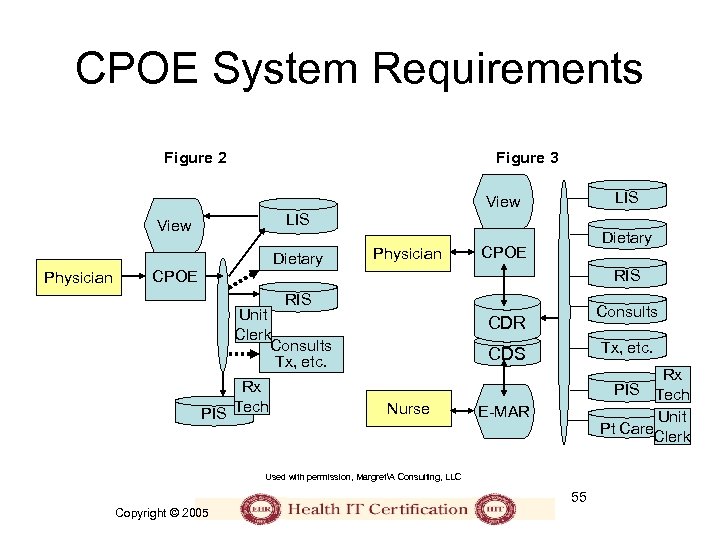 CPOE System Requirements Figure 2 Figure 3 LIS View Dietary Physician Dietary CPOE RIS Unit Clerk Consults Tx, etc. Rx PIS Tech Consults CDR Tx, etc. CDS Nurse Rx PIS Tech Unit Pt Care. Clerk E-MAR Used with permission, MargretA Consulting, LLC 55 Copyright © 2005
CPOE System Requirements Figure 2 Figure 3 LIS View Dietary Physician Dietary CPOE RIS Unit Clerk Consults Tx, etc. Rx PIS Tech Consults CDR Tx, etc. CDS Nurse Rx PIS Tech Unit Pt Care. Clerk E-MAR Used with permission, MargretA Consulting, LLC 55 Copyright © 2005
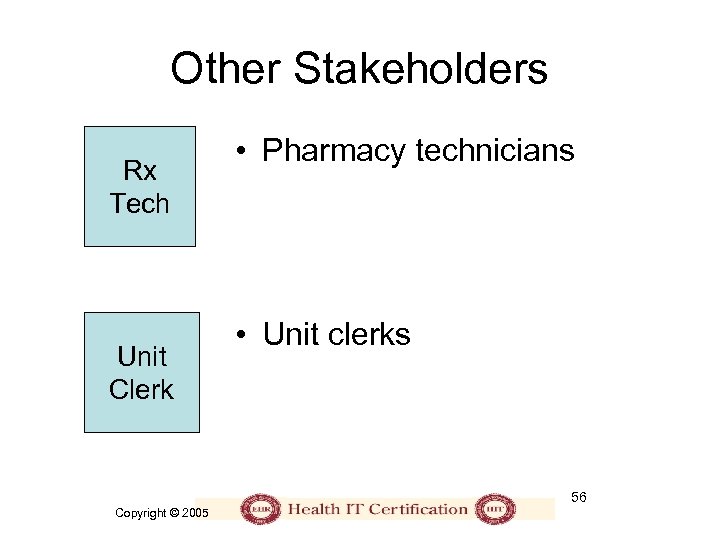 Other Stakeholders Rx Tech Unit Clerk • Pharmacy technicians • Unit clerks 56 Copyright © 2005
Other Stakeholders Rx Tech Unit Clerk • Pharmacy technicians • Unit clerks 56 Copyright © 2005
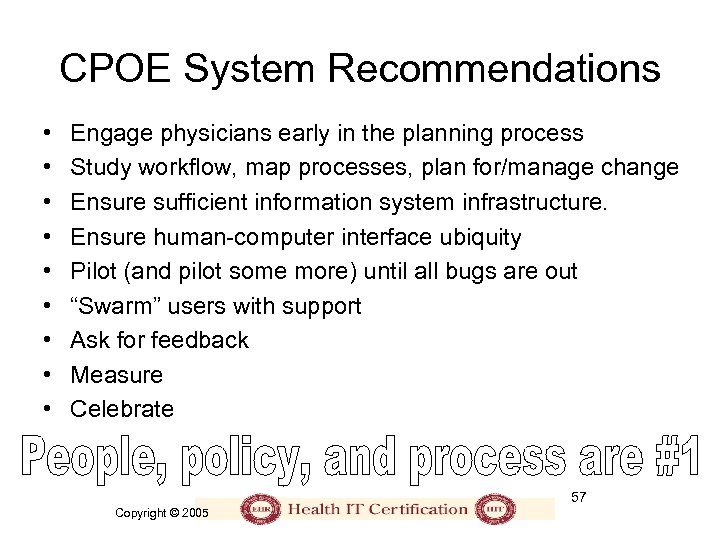 CPOE System Recommendations • • • Engage physicians early in the planning process Study workflow, map processes, plan for/manage change Ensure sufficient information system infrastructure. Ensure human-computer interface ubiquity Pilot (and pilot some more) until all bugs are out “Swarm” users with support Ask for feedback Measure Celebrate 57 Copyright © 2005
CPOE System Recommendations • • • Engage physicians early in the planning process Study workflow, map processes, plan for/manage change Ensure sufficient information system infrastructure. Ensure human-computer interface ubiquity Pilot (and pilot some more) until all bugs are out “Swarm” users with support Ask for feedback Measure Celebrate 57 Copyright © 2005
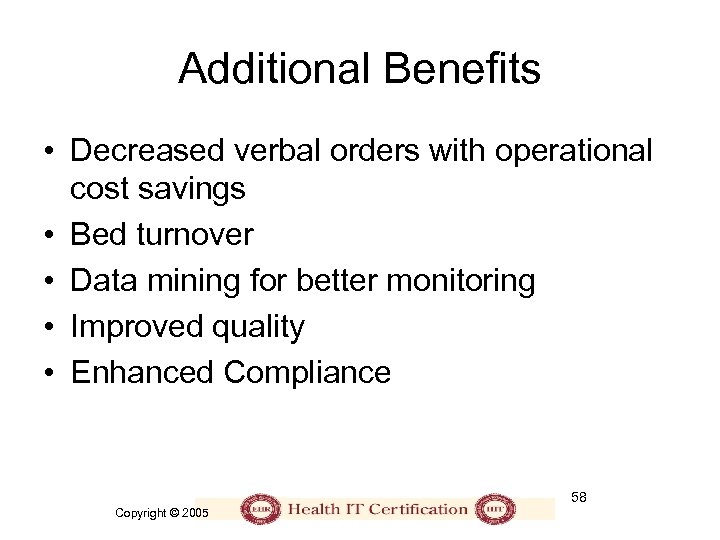 Additional Benefits • Decreased verbal orders with operational cost savings • Bed turnover • Data mining for better monitoring • Improved quality • Enhanced Compliance 58 Copyright © 2005
Additional Benefits • Decreased verbal orders with operational cost savings • Bed turnover • Data mining for better monitoring • Improved quality • Enhanced Compliance 58 Copyright © 2005
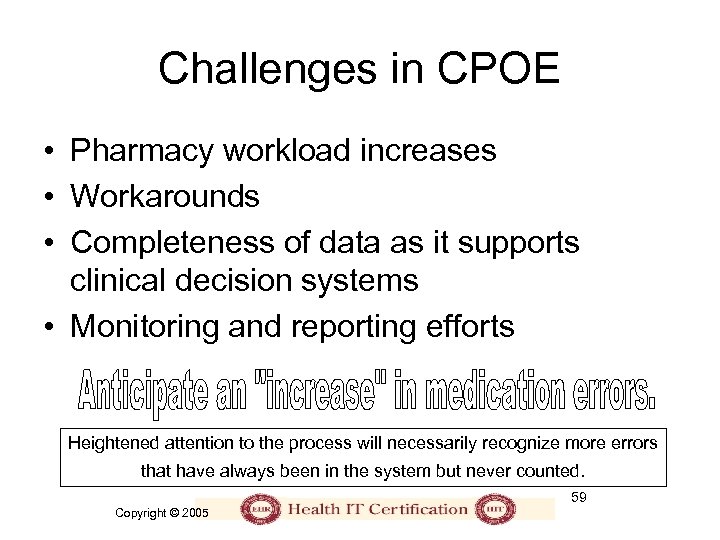 Challenges in CPOE • Pharmacy workload increases • Workarounds • Completeness of data as it supports clinical decision systems • Monitoring and reporting efforts Heightened attention to the process will necessarily recognize more errors that have always been in the system but never counted. 59 Copyright © 2005
Challenges in CPOE • Pharmacy workload increases • Workarounds • Completeness of data as it supports clinical decision systems • Monitoring and reporting efforts Heightened attention to the process will necessarily recognize more errors that have always been in the system but never counted. 59 Copyright © 2005
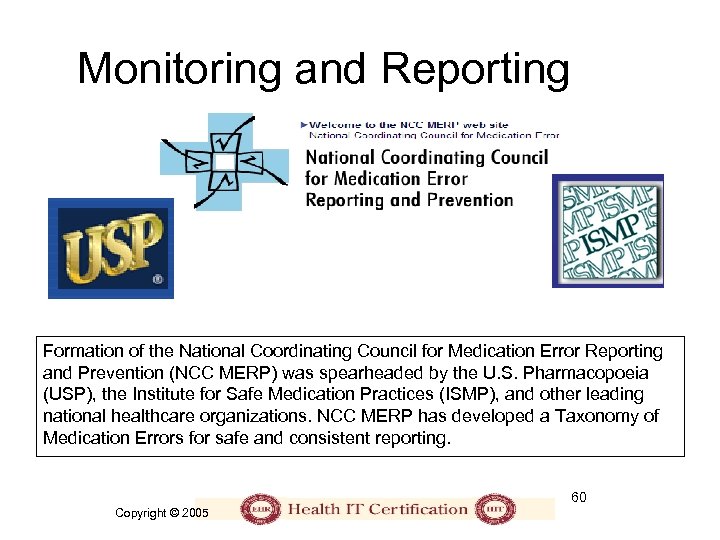 Monitoring and Reporting Formation of the National Coordinating Council for Medication Error Reporting and Prevention (NCC MERP) was spearheaded by the U. S. Pharmacopoeia (USP), the Institute for Safe Medication Practices (ISMP), and other leading national healthcare organizations. NCC MERP has developed a Taxonomy of Medication Errors for safe and consistent reporting. 60 Copyright © 2005
Monitoring and Reporting Formation of the National Coordinating Council for Medication Error Reporting and Prevention (NCC MERP) was spearheaded by the U. S. Pharmacopoeia (USP), the Institute for Safe Medication Practices (ISMP), and other leading national healthcare organizations. NCC MERP has developed a Taxonomy of Medication Errors for safe and consistent reporting. 60 Copyright © 2005
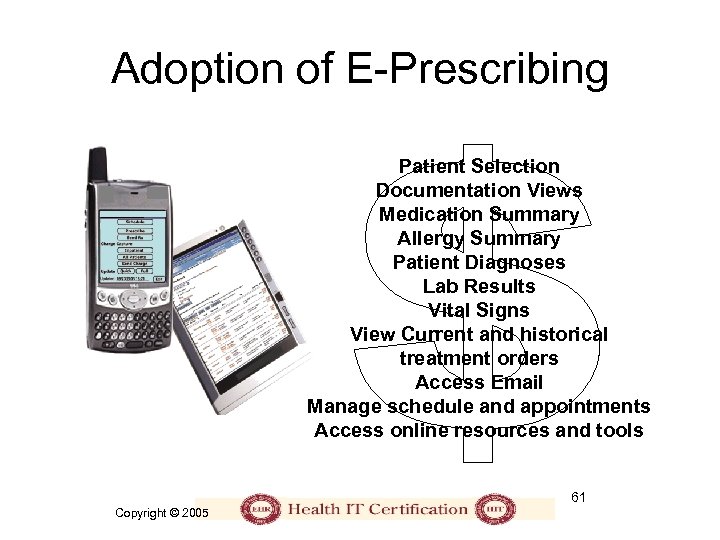 Adoption of E-Prescribing Patient Selection Documentation Views Medication Summary Allergy Summary Patient Diagnoses Lab Results Vital Signs View Current and historical treatment orders Access Email Manage schedule and appointments Access online resources and tools 61 Copyright © 2005
Adoption of E-Prescribing Patient Selection Documentation Views Medication Summary Allergy Summary Patient Diagnoses Lab Results Vital Signs View Current and historical treatment orders Access Email Manage schedule and appointments Access online resources and tools 61 Copyright © 2005
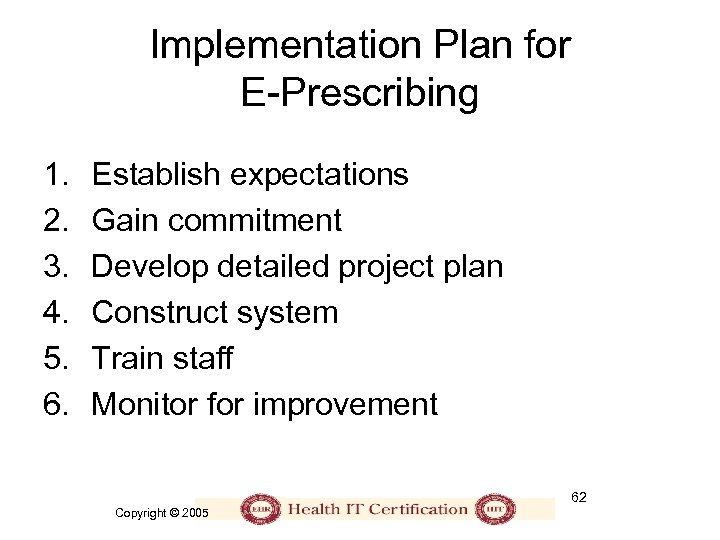 Implementation Plan for E-Prescribing 1. 2. 3. 4. 5. 6. Establish expectations Gain commitment Develop detailed project plan Construct system Train staff Monitor for improvement 62 Copyright © 2005
Implementation Plan for E-Prescribing 1. 2. 3. 4. 5. 6. Establish expectations Gain commitment Develop detailed project plan Construct system Train staff Monitor for improvement 62 Copyright © 2005
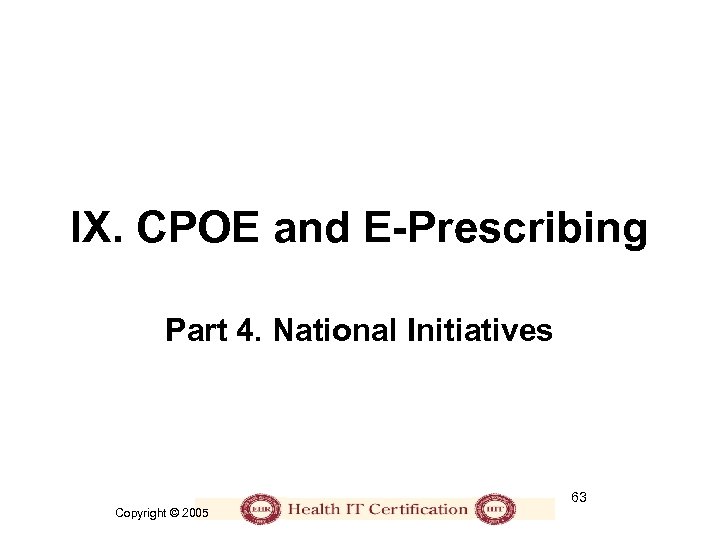 IX. CPOE and E-Prescribing Part 4. National Initiatives 63 Copyright © 2005
IX. CPOE and E-Prescribing Part 4. National Initiatives 63 Copyright © 2005
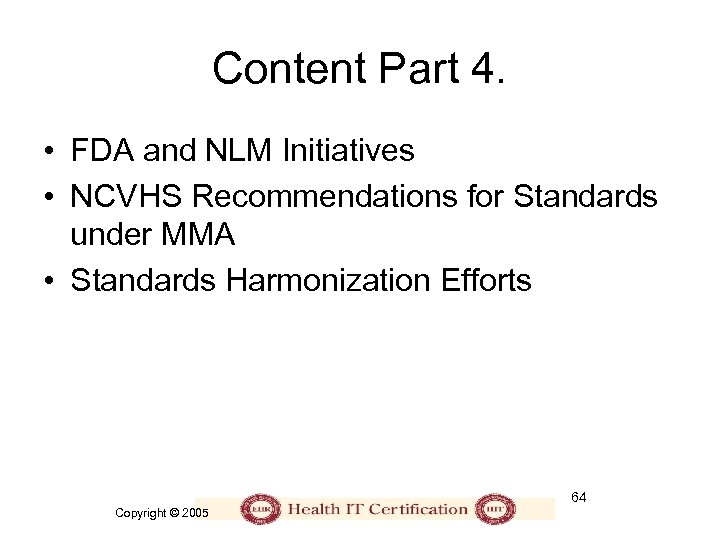 Content Part 4. • FDA and NLM Initiatives • NCVHS Recommendations for Standards under MMA • Standards Harmonization Efforts 64 Copyright © 2005
Content Part 4. • FDA and NLM Initiatives • NCVHS Recommendations for Standards under MMA • Standards Harmonization Efforts 64 Copyright © 2005
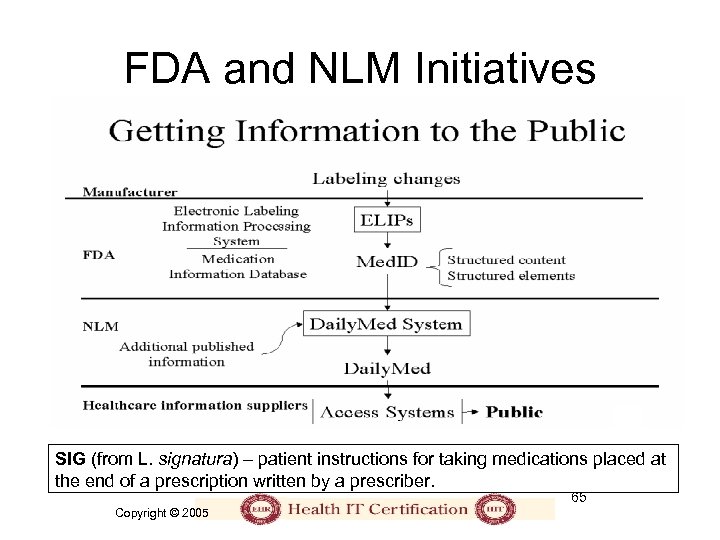 FDA and NLM Initiatives SIG (from L. signatura) – patient instructions for taking medications placed at the end of a prescription written by a prescriber. 65 Copyright © 2005
FDA and NLM Initiatives SIG (from L. signatura) – patient instructions for taking medications placed at the end of a prescription written by a prescriber. 65 Copyright © 2005
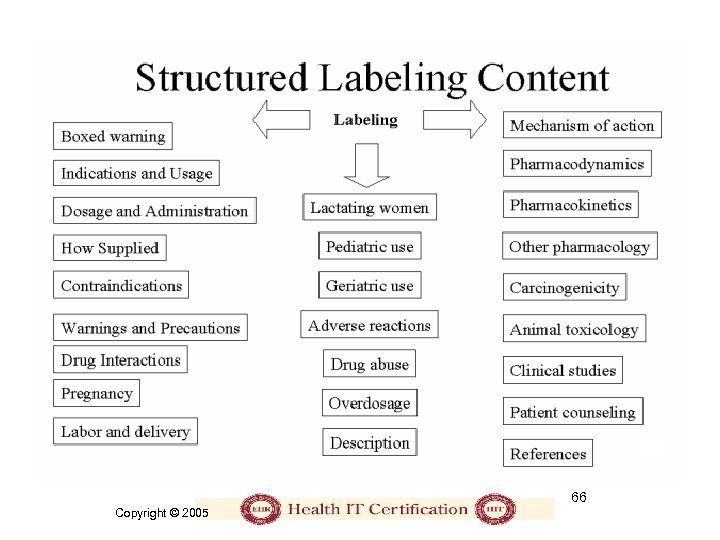 66 Copyright © 2005
66 Copyright © 2005
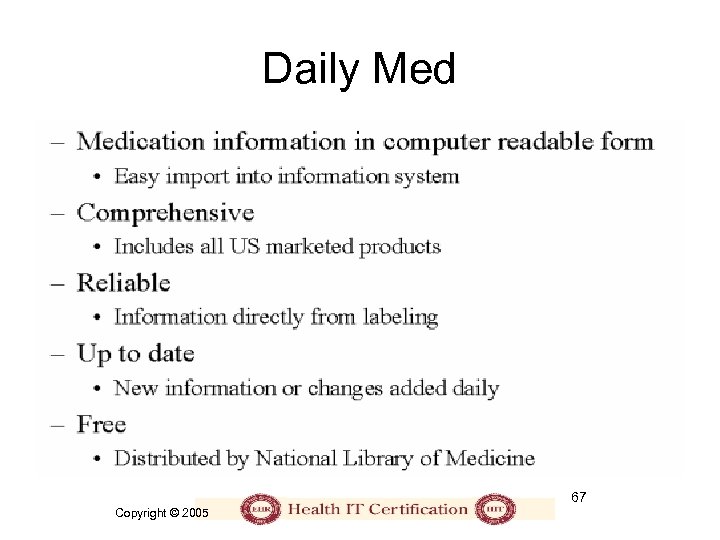 Daily Med 67 Copyright © 2005
Daily Med 67 Copyright © 2005
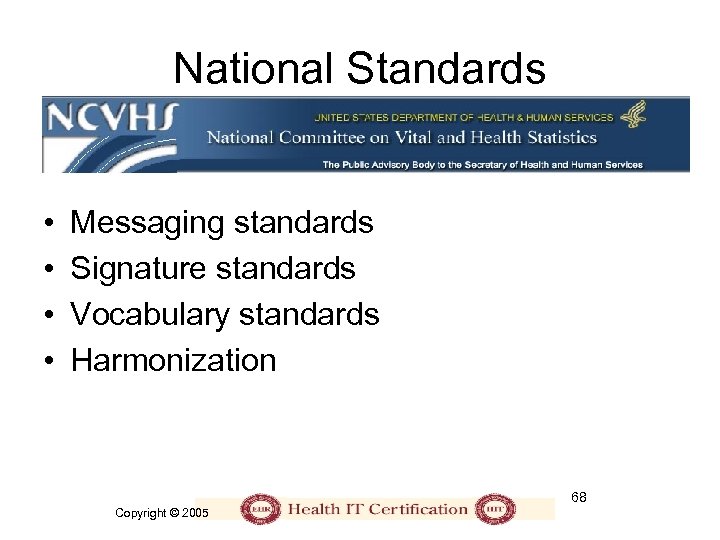 National Standards • • Messaging standards Signature standards Vocabulary standards Harmonization 68 Copyright © 2005
National Standards • • Messaging standards Signature standards Vocabulary standards Harmonization 68 Copyright © 2005
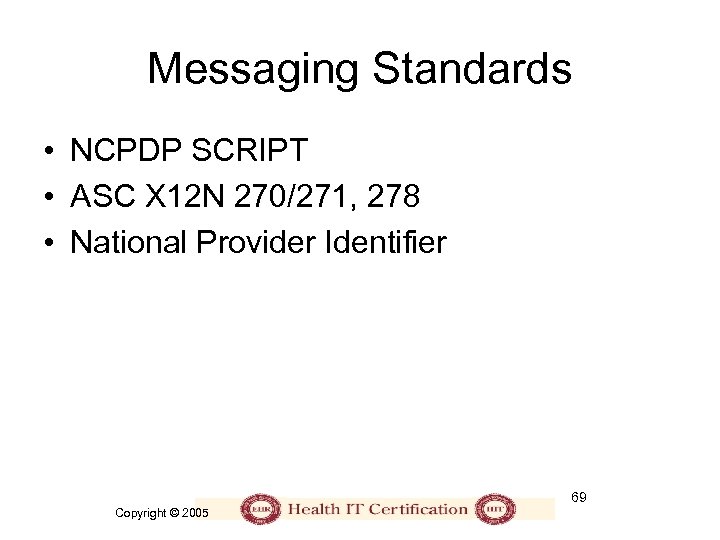 Messaging Standards • NCPDP SCRIPT • ASC X 12 N 270/271, 278 • National Provider Identifier 69 Copyright © 2005
Messaging Standards • NCPDP SCRIPT • ASC X 12 N 270/271, 278 • National Provider Identifier 69 Copyright © 2005
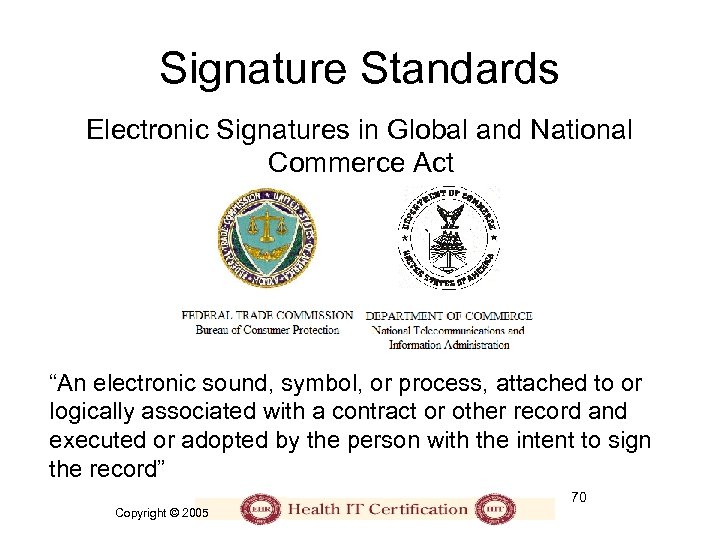 Signature Standards Electronic Signatures in Global and National Commerce Act “An electronic sound, symbol, or process, attached to or logically associated with a contract or other record and executed or adopted by the person with the intent to sign the record” 70 Copyright © 2005
Signature Standards Electronic Signatures in Global and National Commerce Act “An electronic sound, symbol, or process, attached to or logically associated with a contract or other record and executed or adopted by the person with the intent to sign the record” 70 Copyright © 2005
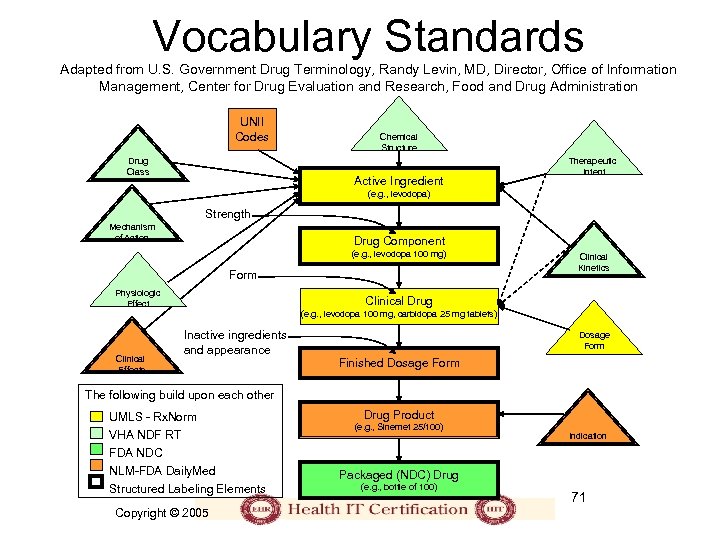 Vocabulary Standards Adapted from U. S. Government Drug Terminology, Randy Levin, MD, Director, Office of Information Management, Center for Drug Evaluation and Research, Food and Drug Administration UNII Codes Drug Class Chemical Structure Active Ingredient Therapeutic Intent (e. g. , levodopa) Strength Mechanism of Action Drug Component (e. g. , levodopa 100 mg) Form Physiologic Effect Clinical Effects Clinical Kinetics Clinical Drug (e. g. , levodopa 100 mg, carbidopa 25 mg tablets) Inactive ingredients and appearance Dosage Form Finished Dosage Form The following build upon each other UMLS - Rx. Norm VHA NDF RT FDA NDC NLM-FDA Daily. Med Structured Labeling Elements Copyright © 2005 Drug Product (e. g. , Sinemet 25/100) Indication Packaged (NDC) Drug (e. g. , bottle of 100) 71
Vocabulary Standards Adapted from U. S. Government Drug Terminology, Randy Levin, MD, Director, Office of Information Management, Center for Drug Evaluation and Research, Food and Drug Administration UNII Codes Drug Class Chemical Structure Active Ingredient Therapeutic Intent (e. g. , levodopa) Strength Mechanism of Action Drug Component (e. g. , levodopa 100 mg) Form Physiologic Effect Clinical Effects Clinical Kinetics Clinical Drug (e. g. , levodopa 100 mg, carbidopa 25 mg tablets) Inactive ingredients and appearance Dosage Form Finished Dosage Form The following build upon each other UMLS - Rx. Norm VHA NDF RT FDA NDC NLM-FDA Daily. Med Structured Labeling Elements Copyright © 2005 Drug Product (e. g. , Sinemet 25/100) Indication Packaged (NDC) Drug (e. g. , bottle of 100) 71
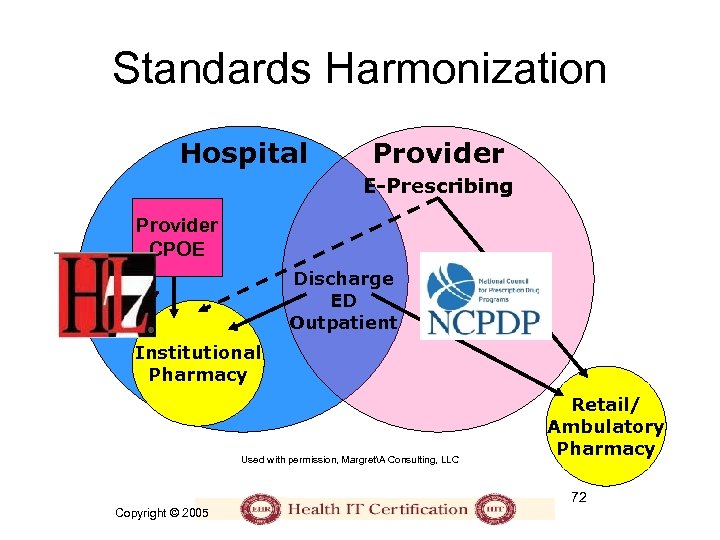 Standards Harmonization Hospital Provider E-Prescribing Provider CPOE Discharge ED Outpatient HL 7 NCPDP Institutional Pharmacy Used with permission, MargretA Consulting, LLC Retail/ Ambulatory Pharmacy 72 Copyright © 2005
Standards Harmonization Hospital Provider E-Prescribing Provider CPOE Discharge ED Outpatient HL 7 NCPDP Institutional Pharmacy Used with permission, MargretA Consulting, LLC Retail/ Ambulatory Pharmacy 72 Copyright © 2005
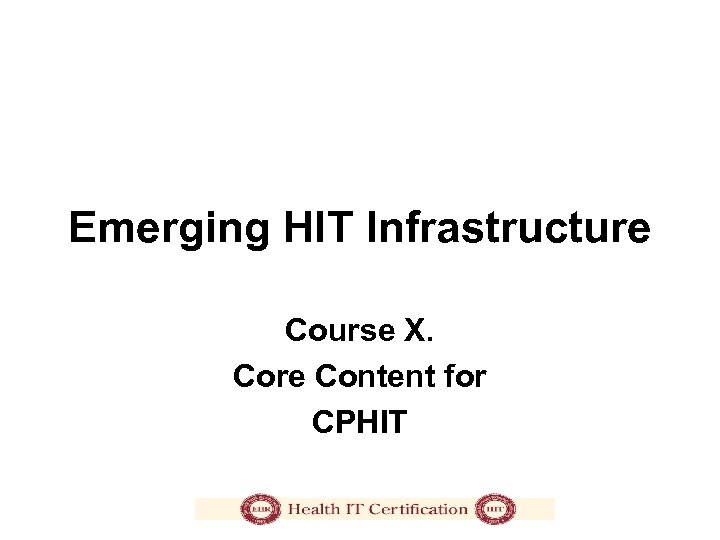 Emerging HIT Infrastructure Course X. Core Content for CPHIT
Emerging HIT Infrastructure Course X. Core Content for CPHIT
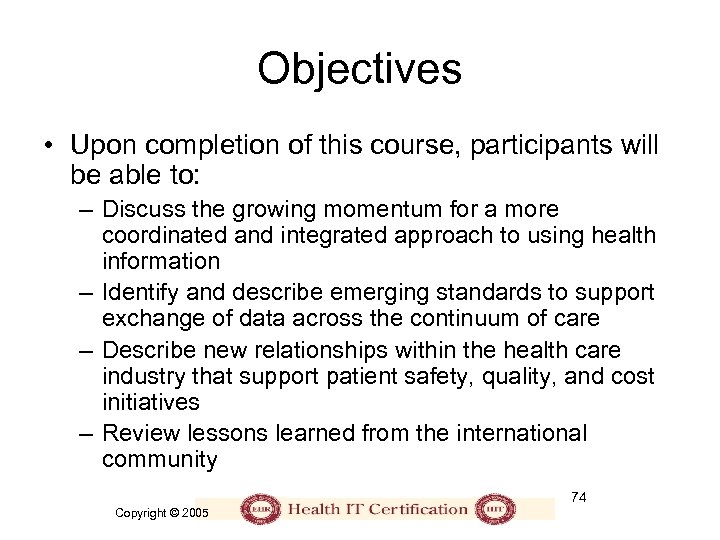 Objectives • Upon completion of this course, participants will be able to: – Discuss the growing momentum for a more coordinated and integrated approach to using health information – Identify and describe emerging standards to support exchange of data across the continuum of care – Describe new relationships within the health care industry that support patient safety, quality, and cost initiatives – Review lessons learned from the international community 74 Copyright © 2005
Objectives • Upon completion of this course, participants will be able to: – Discuss the growing momentum for a more coordinated and integrated approach to using health information – Identify and describe emerging standards to support exchange of data across the continuum of care – Describe new relationships within the health care industry that support patient safety, quality, and cost initiatives – Review lessons learned from the international community 74 Copyright © 2005
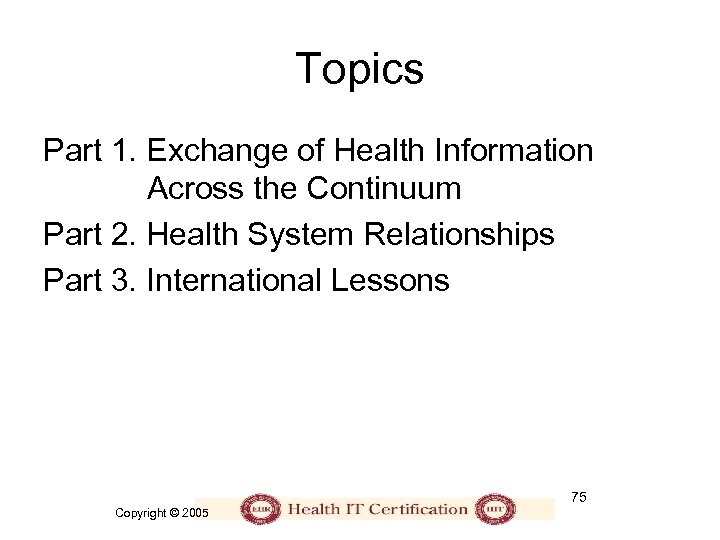 Topics Part 1. Exchange of Health Information Across the Continuum Part 2. Health System Relationships Part 3. International Lessons 75 Copyright © 2005
Topics Part 1. Exchange of Health Information Across the Continuum Part 2. Health System Relationships Part 3. International Lessons 75 Copyright © 2005
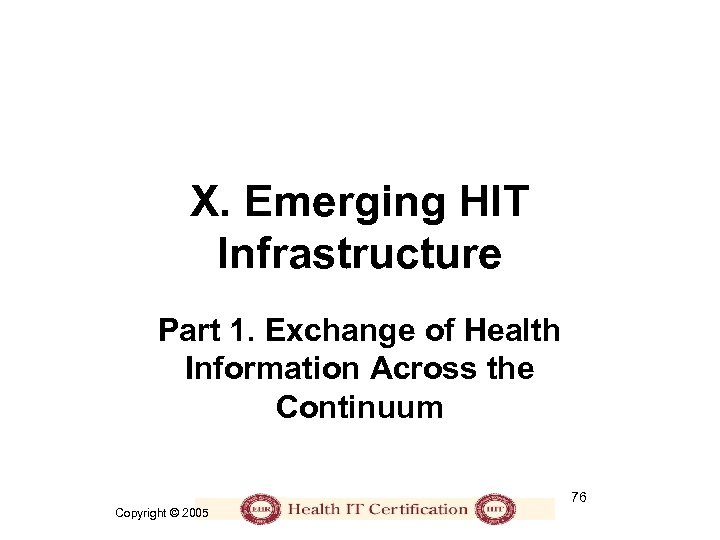 X. Emerging HIT Infrastructure Part 1. Exchange of Health Information Across the Continuum 76 Copyright © 2005
X. Emerging HIT Infrastructure Part 1. Exchange of Health Information Across the Continuum 76 Copyright © 2005
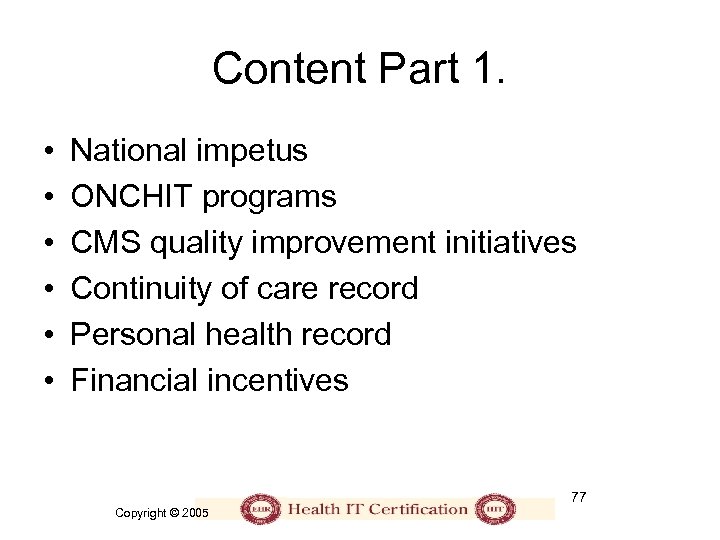 Content Part 1. • • • National impetus ONCHIT programs CMS quality improvement initiatives Continuity of care record Personal health record Financial incentives 77 Copyright © 2005
Content Part 1. • • • National impetus ONCHIT programs CMS quality improvement initiatives Continuity of care record Personal health record Financial incentives 77 Copyright © 2005
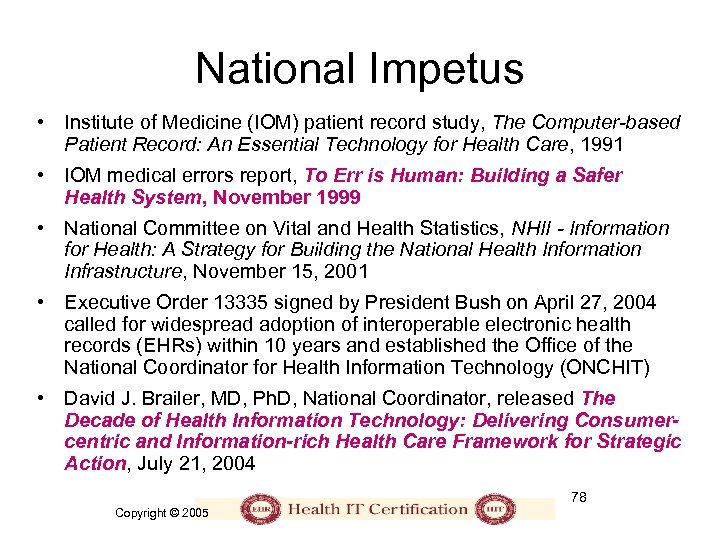 National Impetus • Institute of Medicine (IOM) patient record study, The Computer-based Patient Record: An Essential Technology for Health Care, 1991 • IOM medical errors report, To Err is Human: Building a Safer Health System, November 1999 • National Committee on Vital and Health Statistics, NHII - Information for Health: A Strategy for Building the National Health Information Infrastructure, November 15, 2001 • Executive Order 13335 signed by President Bush on April 27, 2004 called for widespread adoption of interoperable electronic health records (EHRs) within 10 years and established the Office of the National Coordinator for Health Information Technology (ONCHIT) • David J. Brailer, MD, Ph. D, National Coordinator, released The Decade of Health Information Technology: Delivering Consumercentric and Information-rich Health Care Framework for Strategic Action, July 21, 2004 78 Copyright © 2005
National Impetus • Institute of Medicine (IOM) patient record study, The Computer-based Patient Record: An Essential Technology for Health Care, 1991 • IOM medical errors report, To Err is Human: Building a Safer Health System, November 1999 • National Committee on Vital and Health Statistics, NHII - Information for Health: A Strategy for Building the National Health Information Infrastructure, November 15, 2001 • Executive Order 13335 signed by President Bush on April 27, 2004 called for widespread adoption of interoperable electronic health records (EHRs) within 10 years and established the Office of the National Coordinator for Health Information Technology (ONCHIT) • David J. Brailer, MD, Ph. D, National Coordinator, released The Decade of Health Information Technology: Delivering Consumercentric and Information-rich Health Care Framework for Strategic Action, July 21, 2004 78 Copyright © 2005
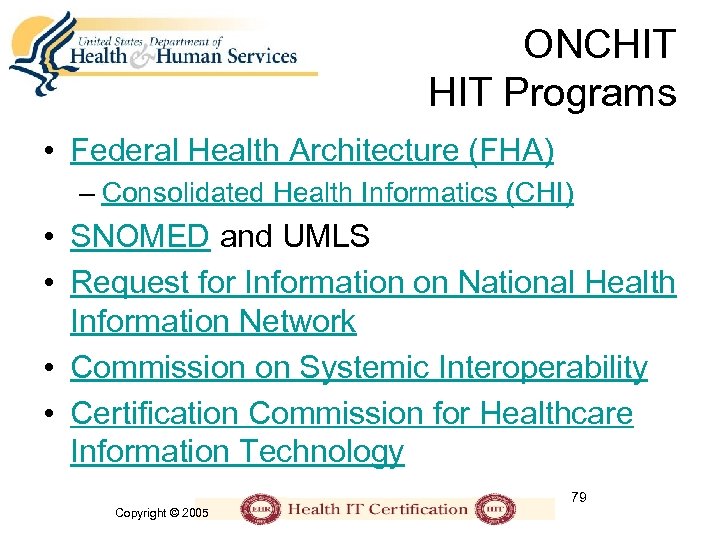 ONCHIT Programs • Federal Health Architecture (FHA) – Consolidated Health Informatics (CHI) • SNOMED and UMLS • Request for Information on National Health Information Network • Commission on Systemic Interoperability • Certification Commission for Healthcare Information Technology 79 Copyright © 2005
ONCHIT Programs • Federal Health Architecture (FHA) – Consolidated Health Informatics (CHI) • SNOMED and UMLS • Request for Information on National Health Information Network • Commission on Systemic Interoperability • Certification Commission for Healthcare Information Technology 79 Copyright © 2005
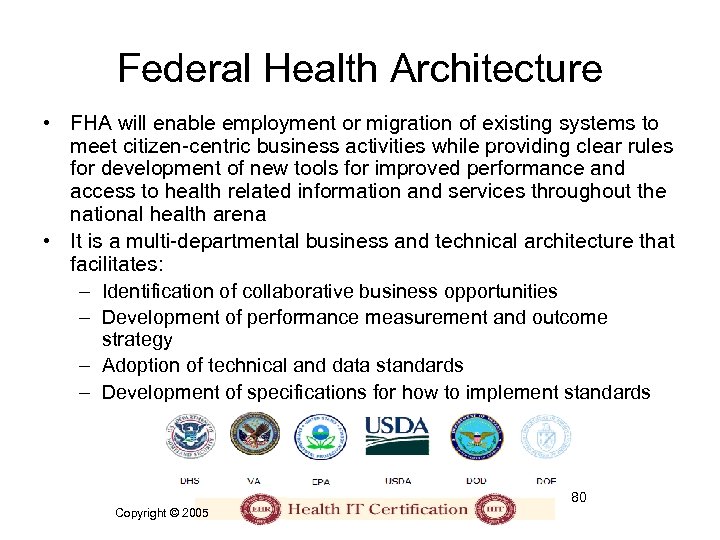 Federal Health Architecture • FHA will enable employment or migration of existing systems to meet citizen-centric business activities while providing clear rules for development of new tools for improved performance and access to health related information and services throughout the national health arena • It is a multi-departmental business and technical architecture that facilitates: – Identification of collaborative business opportunities – Development of performance measurement and outcome strategy – Adoption of technical and data standards – Development of specifications for how to implement standards 80 Copyright © 2005
Federal Health Architecture • FHA will enable employment or migration of existing systems to meet citizen-centric business activities while providing clear rules for development of new tools for improved performance and access to health related information and services throughout the national health arena • It is a multi-departmental business and technical architecture that facilitates: – Identification of collaborative business opportunities – Development of performance measurement and outcome strategy – Adoption of technical and data standards – Development of specifications for how to implement standards 80 Copyright © 2005
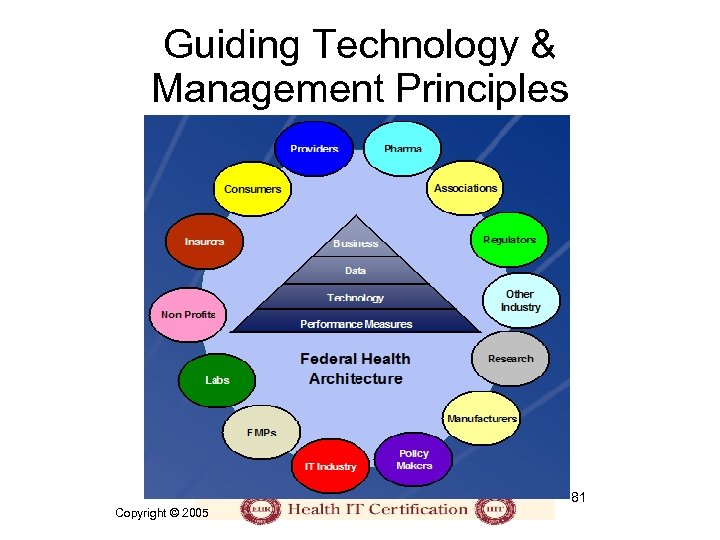 Guiding Technology & Management Principles 81 Copyright © 2005
Guiding Technology & Management Principles 81 Copyright © 2005
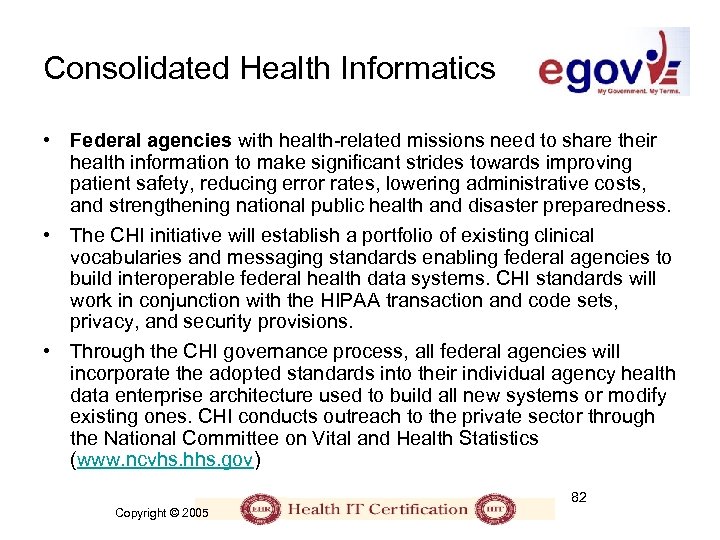 Consolidated Health Informatics • Federal agencies with health-related missions need to share their health information to make significant strides towards improving patient safety, reducing error rates, lowering administrative costs, and strengthening national public health and disaster preparedness. • The CHI initiative will establish a portfolio of existing clinical vocabularies and messaging standards enabling federal agencies to build interoperable federal health data systems. CHI standards will work in conjunction with the HIPAA transaction and code sets, privacy, and security provisions. • Through the CHI governance process, all federal agencies will incorporate the adopted standards into their individual agency health data enterprise architecture used to build all new systems or modify existing ones. CHI conducts outreach to the private sector through the National Committee on Vital and Health Statistics (www. ncvhs. hhs. gov) 82 Copyright © 2005
Consolidated Health Informatics • Federal agencies with health-related missions need to share their health information to make significant strides towards improving patient safety, reducing error rates, lowering administrative costs, and strengthening national public health and disaster preparedness. • The CHI initiative will establish a portfolio of existing clinical vocabularies and messaging standards enabling federal agencies to build interoperable federal health data systems. CHI standards will work in conjunction with the HIPAA transaction and code sets, privacy, and security provisions. • Through the CHI governance process, all federal agencies will incorporate the adopted standards into their individual agency health data enterprise architecture used to build all new systems or modify existing ones. CHI conducts outreach to the private sector through the National Committee on Vital and Health Statistics (www. ncvhs. hhs. gov) 82 Copyright © 2005
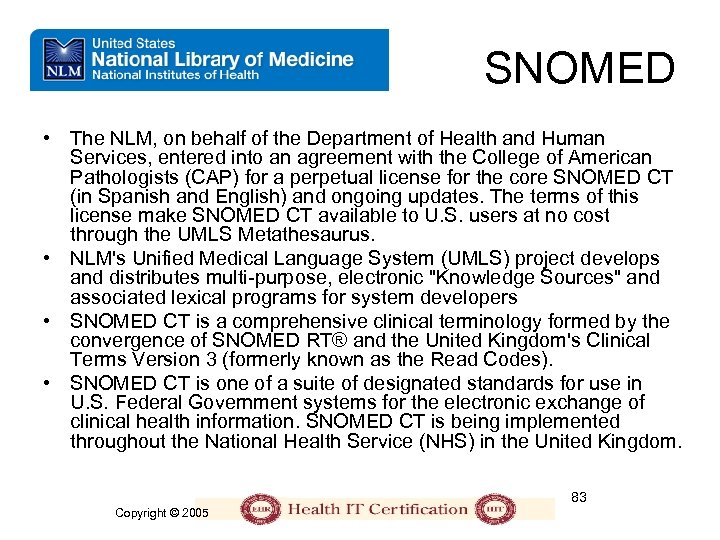 SNOMED • The NLM, on behalf of the Department of Health and Human Services, entered into an agreement with the College of American Pathologists (CAP) for a perpetual license for the core SNOMED CT (in Spanish and English) and ongoing updates. The terms of this license make SNOMED CT available to U. S. users at no cost through the UMLS Metathesaurus. • NLM's Unified Medical Language System (UMLS) project develops and distributes multi-purpose, electronic "Knowledge Sources" and associated lexical programs for system developers • SNOMED CT is a comprehensive clinical terminology formed by the convergence of SNOMED RT® and the United Kingdom's Clinical Terms Version 3 (formerly known as the Read Codes). • SNOMED CT is one of a suite of designated standards for use in U. S. Federal Government systems for the electronic exchange of clinical health information. SNOMED CT is being implemented throughout the National Health Service (NHS) in the United Kingdom. 83 Copyright © 2005
SNOMED • The NLM, on behalf of the Department of Health and Human Services, entered into an agreement with the College of American Pathologists (CAP) for a perpetual license for the core SNOMED CT (in Spanish and English) and ongoing updates. The terms of this license make SNOMED CT available to U. S. users at no cost through the UMLS Metathesaurus. • NLM's Unified Medical Language System (UMLS) project develops and distributes multi-purpose, electronic "Knowledge Sources" and associated lexical programs for system developers • SNOMED CT is a comprehensive clinical terminology formed by the convergence of SNOMED RT® and the United Kingdom's Clinical Terms Version 3 (formerly known as the Read Codes). • SNOMED CT is one of a suite of designated standards for use in U. S. Federal Government systems for the electronic exchange of clinical health information. SNOMED CT is being implemented throughout the National Health Service (NHS) in the United Kingdom. 83 Copyright © 2005
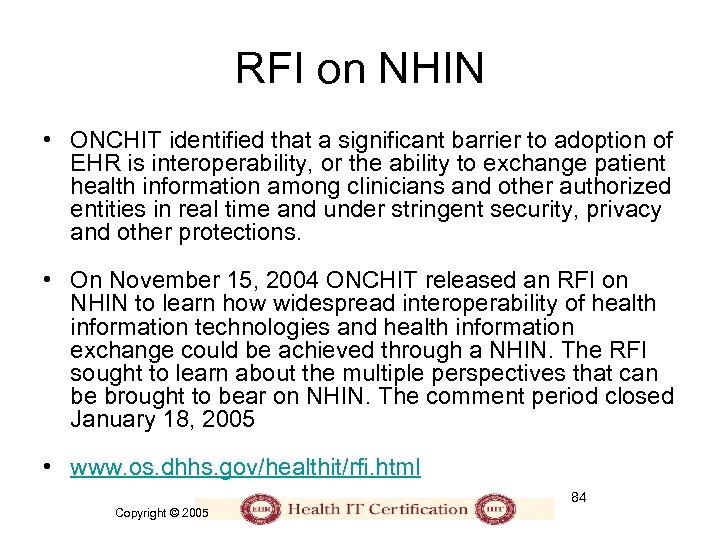 RFI on NHIN • ONCHIT identified that a significant barrier to adoption of EHR is interoperability, or the ability to exchange patient health information among clinicians and other authorized entities in real time and under stringent security, privacy and other protections. • On November 15, 2004 ONCHIT released an RFI on NHIN to learn how widespread interoperability of health information technologies and health information exchange could be achieved through a NHIN. The RFI sought to learn about the multiple perspectives that can be brought to bear on NHIN. The comment period closed January 18, 2005 • www. os. dhhs. gov/healthit/rfi. html 84 Copyright © 2005
RFI on NHIN • ONCHIT identified that a significant barrier to adoption of EHR is interoperability, or the ability to exchange patient health information among clinicians and other authorized entities in real time and under stringent security, privacy and other protections. • On November 15, 2004 ONCHIT released an RFI on NHIN to learn how widespread interoperability of health information technologies and health information exchange could be achieved through a NHIN. The RFI sought to learn about the multiple perspectives that can be brought to bear on NHIN. The comment period closed January 18, 2005 • www. os. dhhs. gov/healthit/rfi. html 84 Copyright © 2005
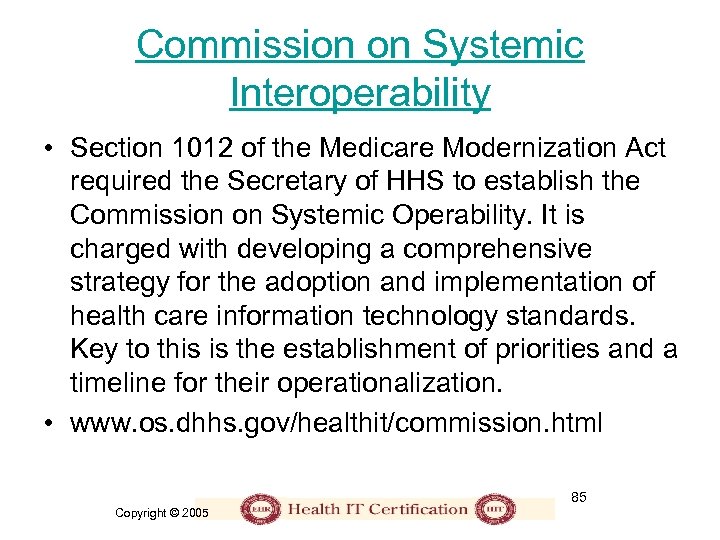 Commission on Systemic Interoperability • Section 1012 of the Medicare Modernization Act required the Secretary of HHS to establish the Commission on Systemic Operability. It is charged with developing a comprehensive strategy for the adoption and implementation of health care information technology standards. Key to this is the establishment of priorities and a timeline for their operationalization. • www. os. dhhs. gov/healthit/commission. html 85 Copyright © 2005
Commission on Systemic Interoperability • Section 1012 of the Medicare Modernization Act required the Secretary of HHS to establish the Commission on Systemic Operability. It is charged with developing a comprehensive strategy for the adoption and implementation of health care information technology standards. Key to this is the establishment of priorities and a timeline for their operationalization. • www. os. dhhs. gov/healthit/commission. html 85 Copyright © 2005
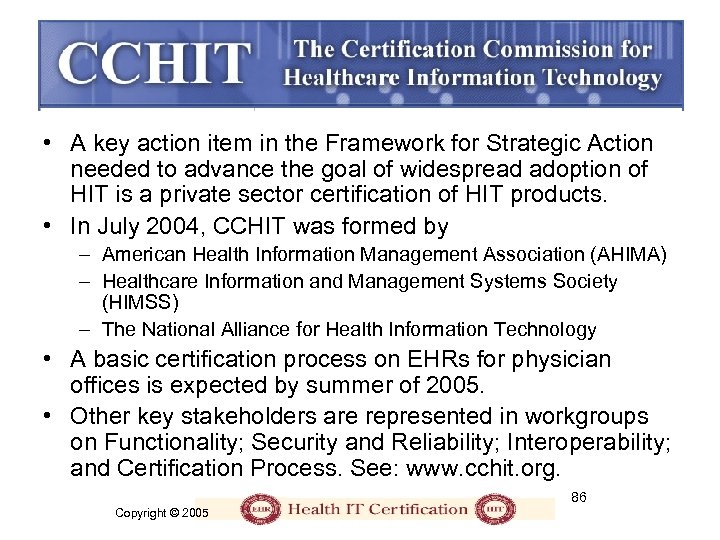 • A key action item in the Framework for Strategic Action needed to advance the goal of widespread adoption of HIT is a private sector certification of HIT products. • In July 2004, CCHIT was formed by – American Health Information Management Association (AHIMA) – Healthcare Information and Management Systems Society (HIMSS) – The National Alliance for Health Information Technology • A basic certification process on EHRs for physician offices is expected by summer of 2005. • Other key stakeholders are represented in workgroups on Functionality; Security and Reliability; Interoperability; and Certification Process. See: www. cchit. org. 86 Copyright © 2005
• A key action item in the Framework for Strategic Action needed to advance the goal of widespread adoption of HIT is a private sector certification of HIT products. • In July 2004, CCHIT was formed by – American Health Information Management Association (AHIMA) – Healthcare Information and Management Systems Society (HIMSS) – The National Alliance for Health Information Technology • A basic certification process on EHRs for physician offices is expected by summer of 2005. • Other key stakeholders are represented in workgroups on Functionality; Security and Reliability; Interoperability; and Certification Process. See: www. cchit. org. 86 Copyright © 2005
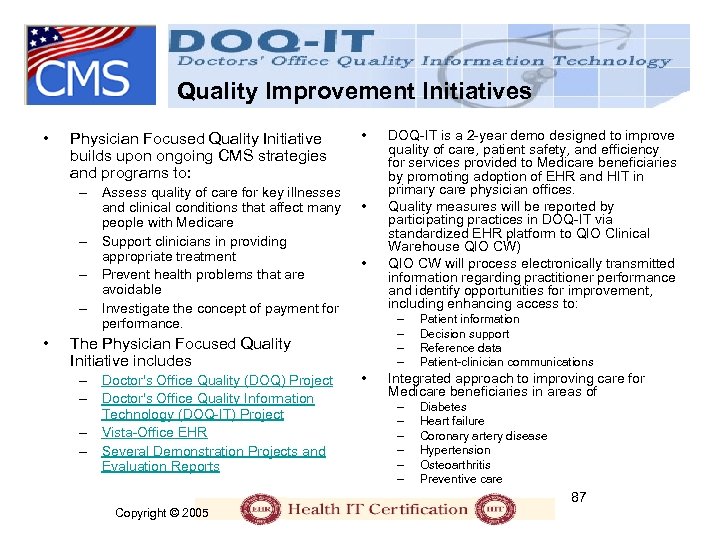 Quality Improvement Initiatives • Physician Focused Quality Initiative builds upon ongoing CMS strategies and programs to: – Assess quality of care for key illnesses and clinical conditions that affect many people with Medicare – Support clinicians in providing appropriate treatment – Prevent health problems that are avoidable – Investigate the concept of payment for performance. • • – – The Physician Focused Quality Initiative includes – Doctor's Office Quality (DOQ) Project – Doctor's Office Quality Information Technology (DOQ-IT) Project – Vista-Office EHR – Several Demonstration Projects and Evaluation Reports DOQ-IT is a 2 -year demo designed to improve quality of care, patient safety, and efficiency for services provided to Medicare beneficiaries by promoting adoption of EHR and HIT in primary care physician offices. Quality measures will be reported by participating practices in DOQ-IT via standardized EHR platform to QIO Clinical Warehouse QIO CW) QIO CW will process electronically transmitted information regarding practitioner performance and identify opportunities for improvement, including enhancing access to: • Patient information Decision support Reference data Patient-clinician communications Integrated approach to improving care for Medicare beneficiaries in areas of – – – Diabetes Heart failure Coronary artery disease Hypertension Osteoarthritis Preventive care 87 Copyright © 2005
Quality Improvement Initiatives • Physician Focused Quality Initiative builds upon ongoing CMS strategies and programs to: – Assess quality of care for key illnesses and clinical conditions that affect many people with Medicare – Support clinicians in providing appropriate treatment – Prevent health problems that are avoidable – Investigate the concept of payment for performance. • • – – The Physician Focused Quality Initiative includes – Doctor's Office Quality (DOQ) Project – Doctor's Office Quality Information Technology (DOQ-IT) Project – Vista-Office EHR – Several Demonstration Projects and Evaluation Reports DOQ-IT is a 2 -year demo designed to improve quality of care, patient safety, and efficiency for services provided to Medicare beneficiaries by promoting adoption of EHR and HIT in primary care physician offices. Quality measures will be reported by participating practices in DOQ-IT via standardized EHR platform to QIO Clinical Warehouse QIO CW) QIO CW will process electronically transmitted information regarding practitioner performance and identify opportunities for improvement, including enhancing access to: • Patient information Decision support Reference data Patient-clinician communications Integrated approach to improving care for Medicare beneficiaries in areas of – – – Diabetes Heart failure Coronary artery disease Hypertension Osteoarthritis Preventive care 87 Copyright © 2005
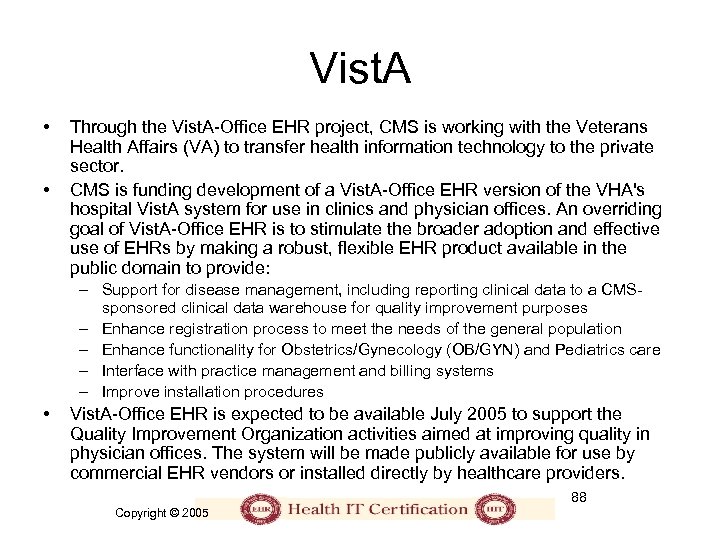 Vist. A • • Through the Vist. A-Office EHR project, CMS is working with the Veterans Health Affairs (VA) to transfer health information technology to the private sector. CMS is funding development of a Vist. A-Office EHR version of the VHA's hospital Vist. A system for use in clinics and physician offices. An overriding goal of Vist. A-Office EHR is to stimulate the broader adoption and effective use of EHRs by making a robust, flexible EHR product available in the public domain to provide: – Support for disease management, including reporting clinical data to a CMSsponsored clinical data warehouse for quality improvement purposes – Enhance registration process to meet the needs of the general population – Enhance functionality for Obstetrics/Gynecology (OB/GYN) and Pediatrics care – Interface with practice management and billing systems – Improve installation procedures • Vist. A-Office EHR is expected to be available July 2005 to support the Quality Improvement Organization activities aimed at improving quality in physician offices. The system will be made publicly available for use by commercial EHR vendors or installed directly by healthcare providers. 88 Copyright © 2005
Vist. A • • Through the Vist. A-Office EHR project, CMS is working with the Veterans Health Affairs (VA) to transfer health information technology to the private sector. CMS is funding development of a Vist. A-Office EHR version of the VHA's hospital Vist. A system for use in clinics and physician offices. An overriding goal of Vist. A-Office EHR is to stimulate the broader adoption and effective use of EHRs by making a robust, flexible EHR product available in the public domain to provide: – Support for disease management, including reporting clinical data to a CMSsponsored clinical data warehouse for quality improvement purposes – Enhance registration process to meet the needs of the general population – Enhance functionality for Obstetrics/Gynecology (OB/GYN) and Pediatrics care – Interface with practice management and billing systems – Improve installation procedures • Vist. A-Office EHR is expected to be available July 2005 to support the Quality Improvement Organization activities aimed at improving quality in physician offices. The system will be made publicly available for use by commercial EHR vendors or installed directly by healthcare providers. 88 Copyright © 2005
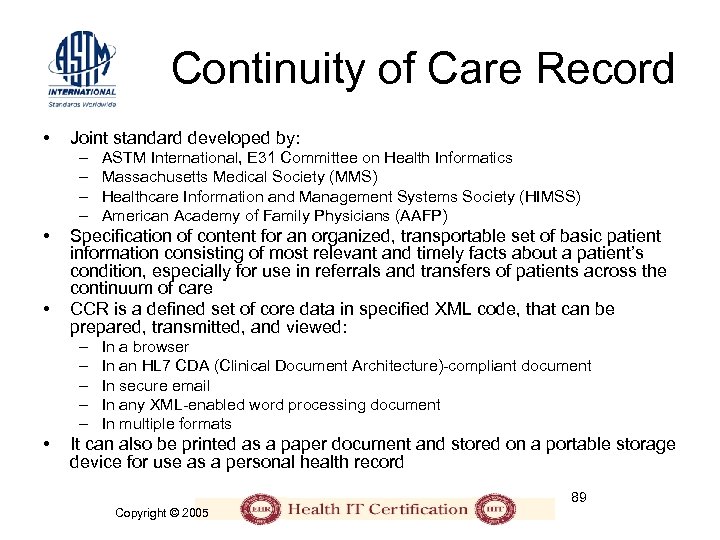 Continuity of Care Record • Joint standard developed by: – – • • Specification of content for an organized, transportable set of basic patient information consisting of most relevant and timely facts about a patient’s condition, especially for use in referrals and transfers of patients across the continuum of care CCR is a defined set of core data in specified XML code, that can be prepared, transmitted, and viewed: – – – • ASTM International, E 31 Committee on Health Informatics Massachusetts Medical Society (MMS) Healthcare Information and Management Systems Society (HIMSS) American Academy of Family Physicians (AAFP) In a browser In an HL 7 CDA (Clinical Document Architecture)-compliant document In secure email In any XML-enabled word processing document In multiple formats It can also be printed as a paper document and stored on a portable storage device for use as a personal health record 89 Copyright © 2005
Continuity of Care Record • Joint standard developed by: – – • • Specification of content for an organized, transportable set of basic patient information consisting of most relevant and timely facts about a patient’s condition, especially for use in referrals and transfers of patients across the continuum of care CCR is a defined set of core data in specified XML code, that can be prepared, transmitted, and viewed: – – – • ASTM International, E 31 Committee on Health Informatics Massachusetts Medical Society (MMS) Healthcare Information and Management Systems Society (HIMSS) American Academy of Family Physicians (AAFP) In a browser In an HL 7 CDA (Clinical Document Architecture)-compliant document In secure email In any XML-enabled word processing document In multiple formats It can also be printed as a paper document and stored on a portable storage device for use as a personal health record 89 Copyright © 2005
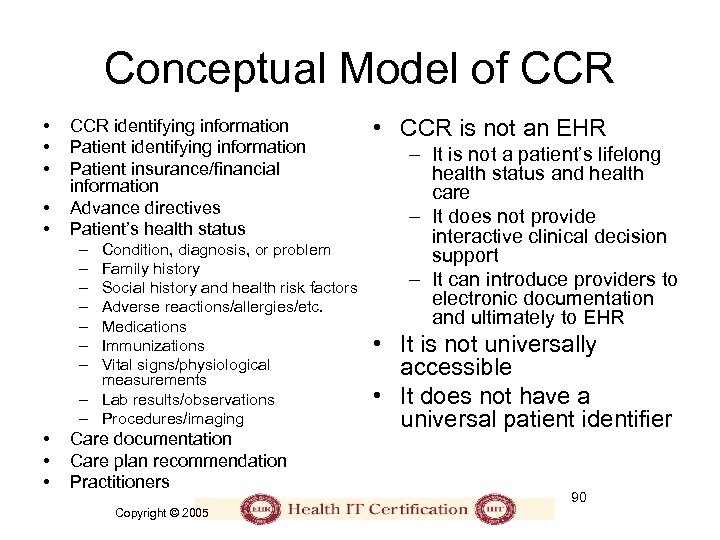 Conceptual Model of CCR • • • CCR identifying information Patient insurance/financial information Advance directives Patient’s health status – – – – Condition, diagnosis, or problem Family history Social history and health risk factors Adverse reactions/allergies/etc. Medications Immunizations Vital signs/physiological measurements – Lab results/observations – Procedures/imaging • • • Care documentation Care plan recommendation Practitioners Copyright © 2005 • CCR is not an EHR – It is not a patient’s lifelong health status and health care – It does not provide interactive clinical decision support – It can introduce providers to electronic documentation and ultimately to EHR • It is not universally accessible • It does not have a universal patient identifier 90
Conceptual Model of CCR • • • CCR identifying information Patient insurance/financial information Advance directives Patient’s health status – – – – Condition, diagnosis, or problem Family history Social history and health risk factors Adverse reactions/allergies/etc. Medications Immunizations Vital signs/physiological measurements – Lab results/observations – Procedures/imaging • • • Care documentation Care plan recommendation Practitioners Copyright © 2005 • CCR is not an EHR – It is not a patient’s lifelong health status and health care – It does not provide interactive clinical decision support – It can introduce providers to electronic documentation and ultimately to EHR • It is not universally accessible • It does not have a universal patient identifier 90
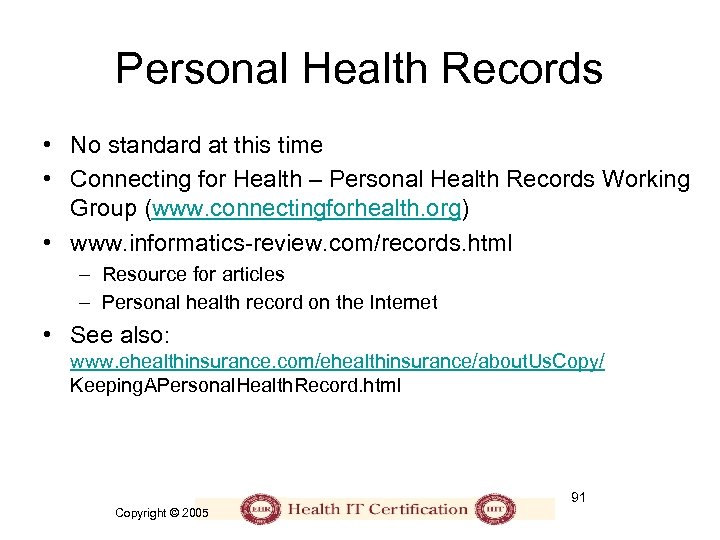 Personal Health Records • No standard at this time • Connecting for Health – Personal Health Records Working Group (www. connectingforhealth. org) • www. informatics-review. com/records. html – Resource for articles – Personal health record on the Internet • See also: www. ehealthinsurance. com/ehealthinsurance/about. Us. Copy/ Keeping. APersonal. Health. Record. html 91 Copyright © 2005
Personal Health Records • No standard at this time • Connecting for Health – Personal Health Records Working Group (www. connectingforhealth. org) • www. informatics-review. com/records. html – Resource for articles – Personal health record on the Internet • See also: www. ehealthinsurance. com/ehealthinsurance/about. Us. Copy/ Keeping. APersonal. Health. Record. html 91 Copyright © 2005
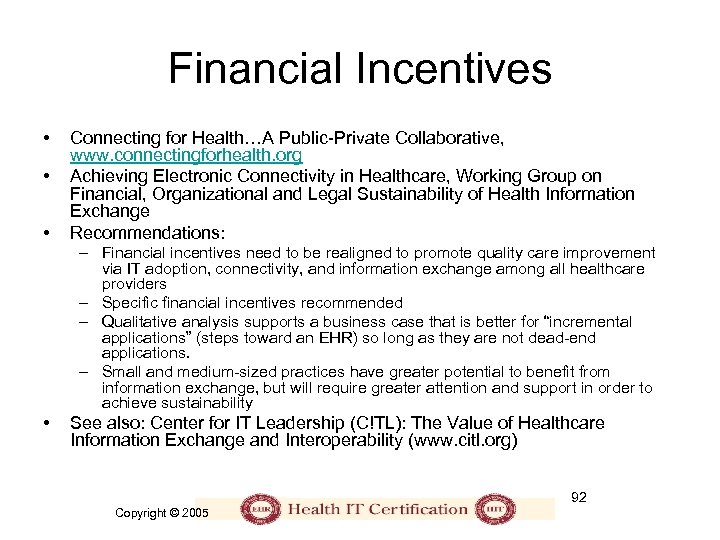 Financial Incentives • • • Connecting for Health…A Public-Private Collaborative, www. connectingforhealth. org Achieving Electronic Connectivity in Healthcare, Working Group on Financial, Organizational and Legal Sustainability of Health Information Exchange Recommendations: – Financial incentives need to be realigned to promote quality care improvement via IT adoption, connectivity, and information exchange among all healthcare providers – Specific financial incentives recommended – Qualitative analysis supports a business case that is better for “incremental applications” (steps toward an EHR) so long as they are not dead-end applications. – Small and medium-sized practices have greater potential to benefit from information exchange, but will require greater attention and support in order to achieve sustainability • See also: Center for IT Leadership (C!TL): The Value of Healthcare Information Exchange and Interoperability (www. citl. org) 92 Copyright © 2005
Financial Incentives • • • Connecting for Health…A Public-Private Collaborative, www. connectingforhealth. org Achieving Electronic Connectivity in Healthcare, Working Group on Financial, Organizational and Legal Sustainability of Health Information Exchange Recommendations: – Financial incentives need to be realigned to promote quality care improvement via IT adoption, connectivity, and information exchange among all healthcare providers – Specific financial incentives recommended – Qualitative analysis supports a business case that is better for “incremental applications” (steps toward an EHR) so long as they are not dead-end applications. – Small and medium-sized practices have greater potential to benefit from information exchange, but will require greater attention and support in order to achieve sustainability • See also: Center for IT Leadership (C!TL): The Value of Healthcare Information Exchange and Interoperability (www. citl. org) 92 Copyright © 2005
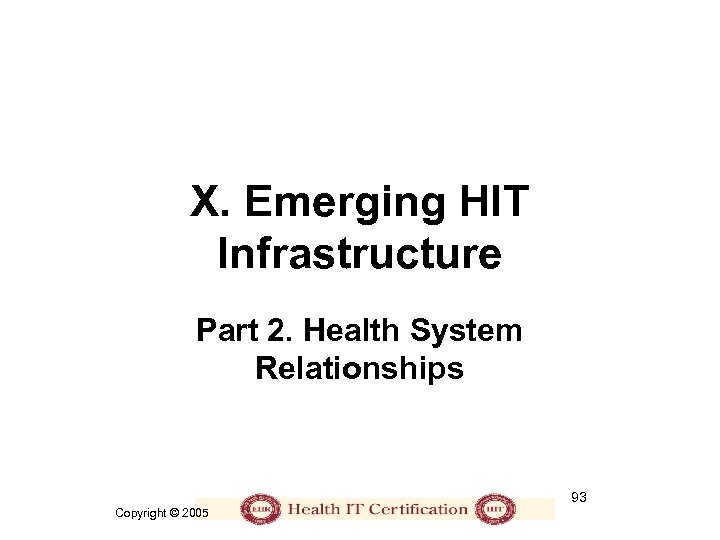 X. Emerging HIT Infrastructure Part 2. Health System Relationships 93 Copyright © 2005
X. Emerging HIT Infrastructure Part 2. Health System Relationships 93 Copyright © 2005
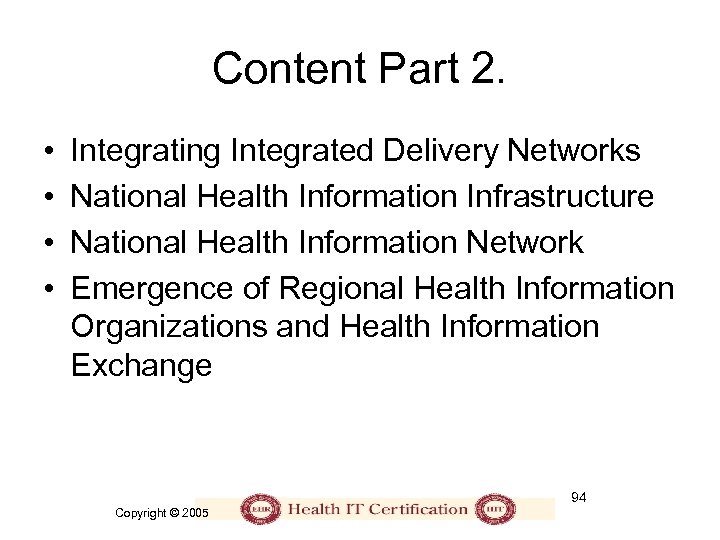 Content Part 2. • • Integrating Integrated Delivery Networks National Health Information Infrastructure National Health Information Network Emergence of Regional Health Information Organizations and Health Information Exchange 94 Copyright © 2005
Content Part 2. • • Integrating Integrated Delivery Networks National Health Information Infrastructure National Health Information Network Emergence of Regional Health Information Organizations and Health Information Exchange 94 Copyright © 2005
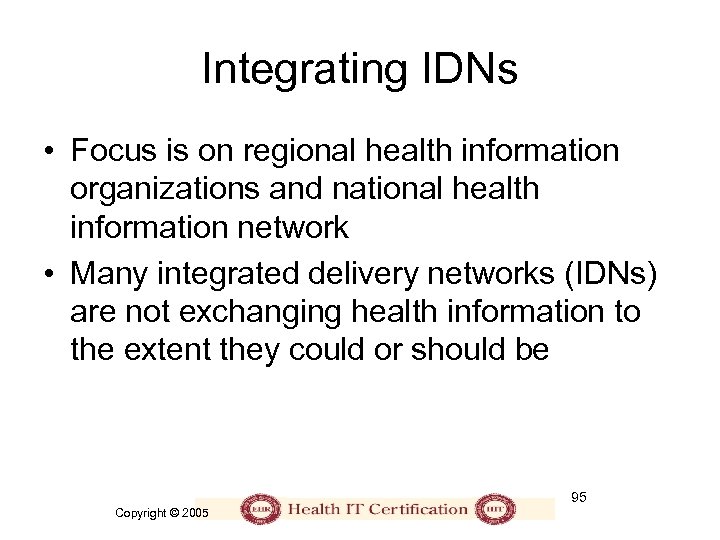 Integrating IDNs • Focus is on regional health information organizations and national health information network • Many integrated delivery networks (IDNs) are not exchanging health information to the extent they could or should be 95 Copyright © 2005
Integrating IDNs • Focus is on regional health information organizations and national health information network • Many integrated delivery networks (IDNs) are not exchanging health information to the extent they could or should be 95 Copyright © 2005
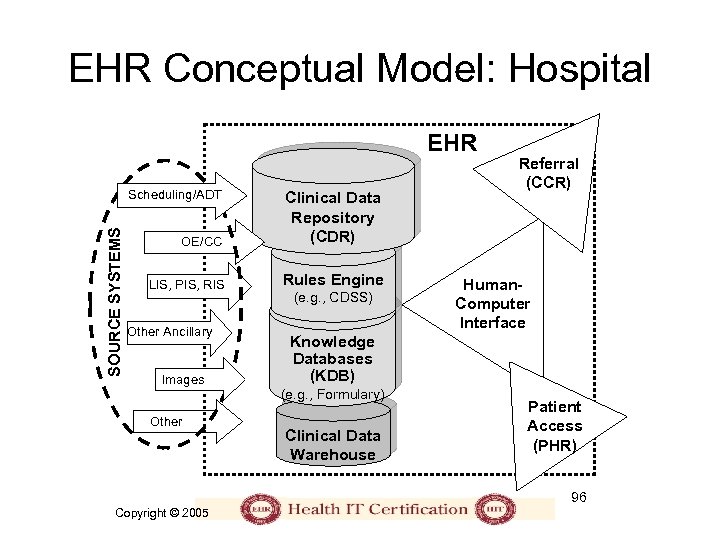 EHR Conceptual Model: Hospital EHR SOURCE SYSTEMS Scheduling/ADT OE/CC Clinical Data Repository (CDR) LIS, PIS, RIS Rules Engine Other Ancillary Images Other (e. g. , CDSS) Referral (CCR) Human. Computer Interface Knowledge Databases (KDB) (e. g. , Formulary) Clinical Data Warehouse Patient Access (PHR) 96 Copyright © 2005
EHR Conceptual Model: Hospital EHR SOURCE SYSTEMS Scheduling/ADT OE/CC Clinical Data Repository (CDR) LIS, PIS, RIS Rules Engine Other Ancillary Images Other (e. g. , CDSS) Referral (CCR) Human. Computer Interface Knowledge Databases (KDB) (e. g. , Formulary) Clinical Data Warehouse Patient Access (PHR) 96 Copyright © 2005
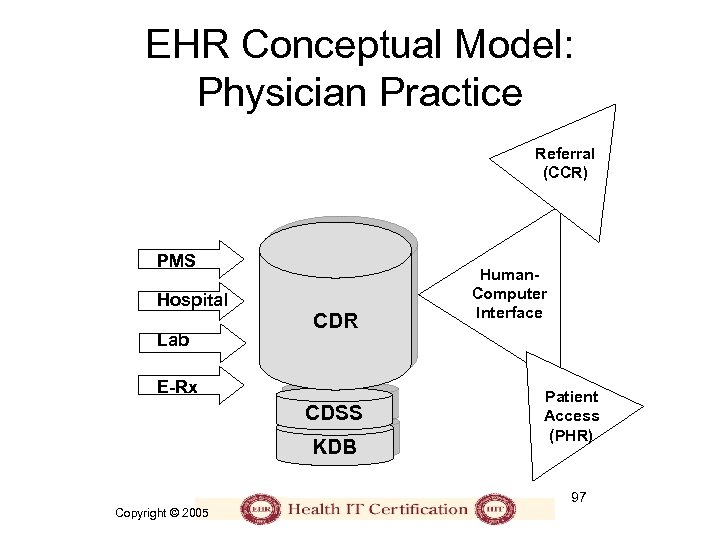 EHR Conceptual Model: Physician Practice Referral (CCR) PMS Hospital Lab CDR E-Rx CDSS KDB Human. Computer Interface Patient Access (PHR) 97 Copyright © 2005
EHR Conceptual Model: Physician Practice Referral (CCR) PMS Hospital Lab CDR E-Rx CDSS KDB Human. Computer Interface Patient Access (PHR) 97 Copyright © 2005
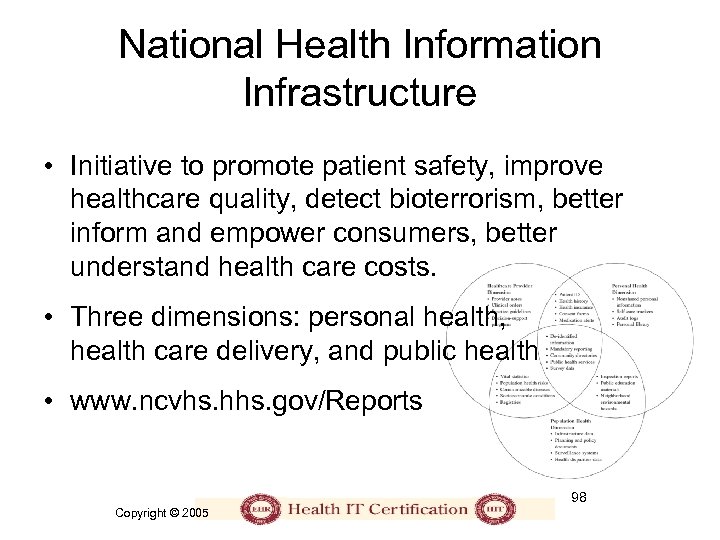 National Health Information Infrastructure • Initiative to promote patient safety, improve healthcare quality, detect bioterrorism, better inform and empower consumers, better understand health care costs. • Three dimensions: personal health, health care delivery, and public health • www. ncvhs. hhs. gov/Reports 98 Copyright © 2005
National Health Information Infrastructure • Initiative to promote patient safety, improve healthcare quality, detect bioterrorism, better inform and empower consumers, better understand health care costs. • Three dimensions: personal health, health care delivery, and public health • www. ncvhs. hhs. gov/Reports 98 Copyright © 2005
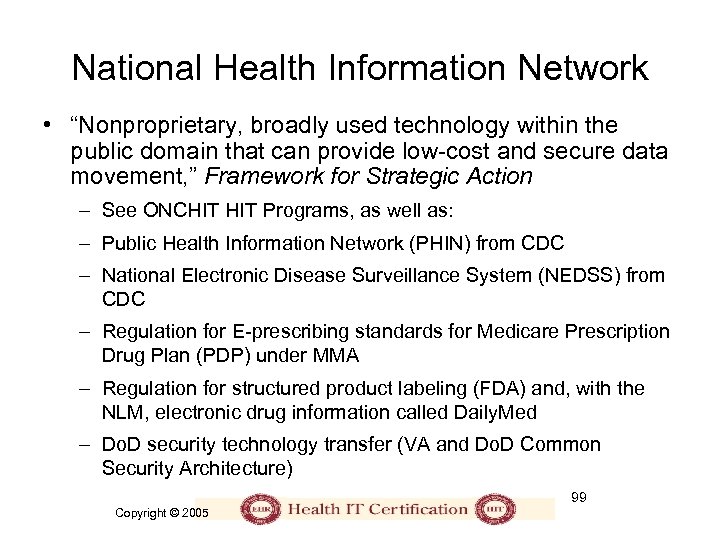 National Health Information Network • “Nonproprietary, broadly used technology within the public domain that can provide low-cost and secure data movement, ” Framework for Strategic Action – See ONCHIT Programs, as well as: – Public Health Information Network (PHIN) from CDC – National Electronic Disease Surveillance System (NEDSS) from CDC – Regulation for E-prescribing standards for Medicare Prescription Drug Plan (PDP) under MMA – Regulation for structured product labeling (FDA) and, with the NLM, electronic drug information called Daily. Med – Do. D security technology transfer (VA and Do. D Common Security Architecture) 99 Copyright © 2005
National Health Information Network • “Nonproprietary, broadly used technology within the public domain that can provide low-cost and secure data movement, ” Framework for Strategic Action – See ONCHIT Programs, as well as: – Public Health Information Network (PHIN) from CDC – National Electronic Disease Surveillance System (NEDSS) from CDC – Regulation for E-prescribing standards for Medicare Prescription Drug Plan (PDP) under MMA – Regulation for structured product labeling (FDA) and, with the NLM, electronic drug information called Daily. Med – Do. D security technology transfer (VA and Do. D Common Security Architecture) 99 Copyright © 2005
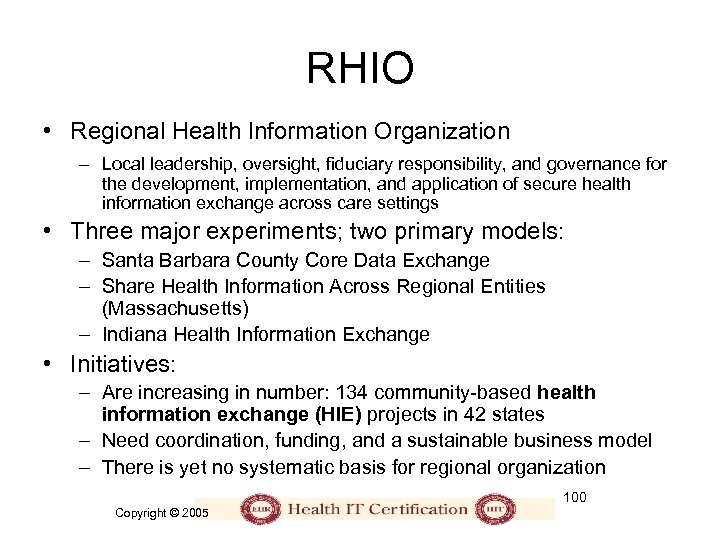 RHIO • Regional Health Information Organization – Local leadership, oversight, fiduciary responsibility, and governance for the development, implementation, and application of secure health information exchange across care settings • Three major experiments; two primary models: – Santa Barbara County Core Data Exchange – Share Health Information Across Regional Entities (Massachusetts) – Indiana Health Information Exchange • Initiatives: – Are increasing in number: 134 community-based health information exchange (HIE) projects in 42 states – Need coordination, funding, and a sustainable business model – There is yet no systematic basis for regional organization 100 Copyright © 2005
RHIO • Regional Health Information Organization – Local leadership, oversight, fiduciary responsibility, and governance for the development, implementation, and application of secure health information exchange across care settings • Three major experiments; two primary models: – Santa Barbara County Core Data Exchange – Share Health Information Across Regional Entities (Massachusetts) – Indiana Health Information Exchange • Initiatives: – Are increasing in number: 134 community-based health information exchange (HIE) projects in 42 states – Need coordination, funding, and a sustainable business model – There is yet no systematic basis for regional organization 100 Copyright © 2005
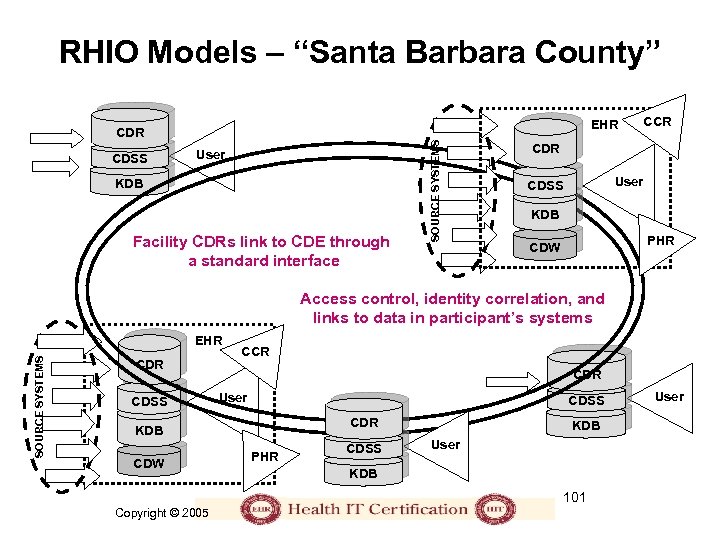 RHIO Models – “Santa Barbara County” CDSS User KDB Facility CDRs link to CDE through a standard interface SOURCE SYSTEMS EHR CDR CCR CDR User CDSS KDB PHR CDW Access control, identity correlation, and links to data in participant’s systems SOURCE SYSTEMS EHR CDSS CCR CDR User CDSS CDR KDB CDW PHR CDSS KDB User KDB 101 Copyright © 2005 User
RHIO Models – “Santa Barbara County” CDSS User KDB Facility CDRs link to CDE through a standard interface SOURCE SYSTEMS EHR CDR CCR CDR User CDSS KDB PHR CDW Access control, identity correlation, and links to data in participant’s systems SOURCE SYSTEMS EHR CDSS CCR CDR User CDSS CDR KDB CDW PHR CDSS KDB User KDB 101 Copyright © 2005 User
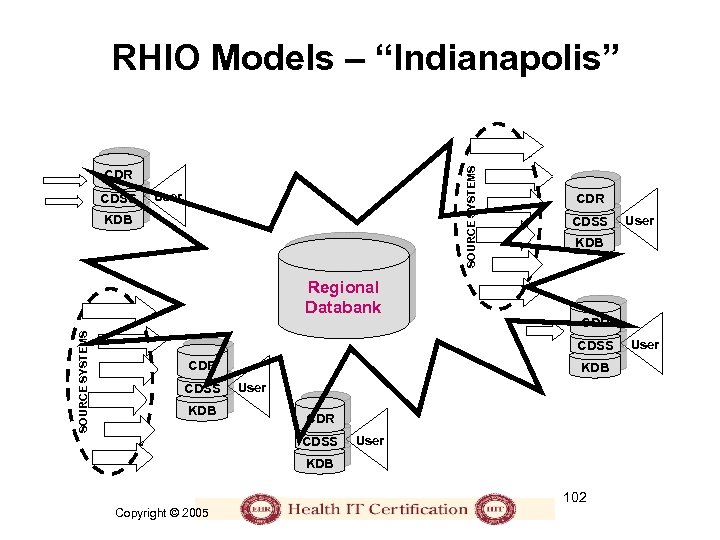 SOURCE SYSTEMS RHIO Models – “Indianapolis” CDR CDSS User KDB SOURCE SYSTEMS Regional Databank CDR CDSS KDB User CDR CDSS User KDB 102 Copyright © 2005 User
SOURCE SYSTEMS RHIO Models – “Indianapolis” CDR CDSS User KDB SOURCE SYSTEMS Regional Databank CDR CDSS KDB User CDR CDSS User KDB 102 Copyright © 2005 User
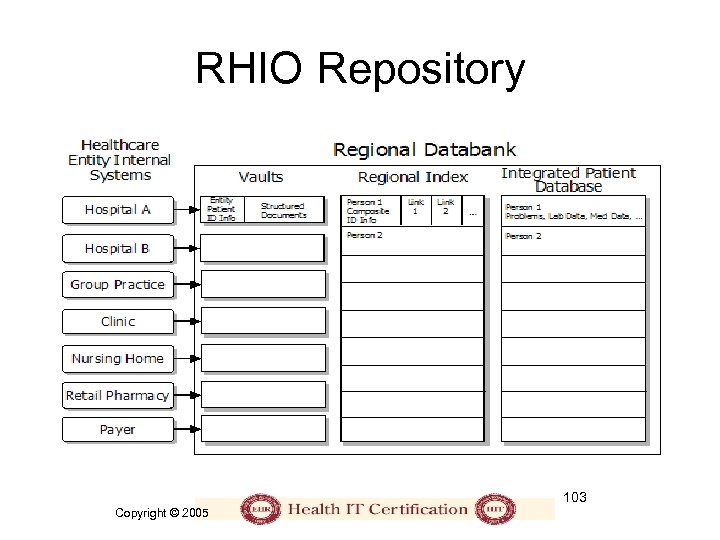 RHIO Repository 103 Copyright © 2005
RHIO Repository 103 Copyright © 2005
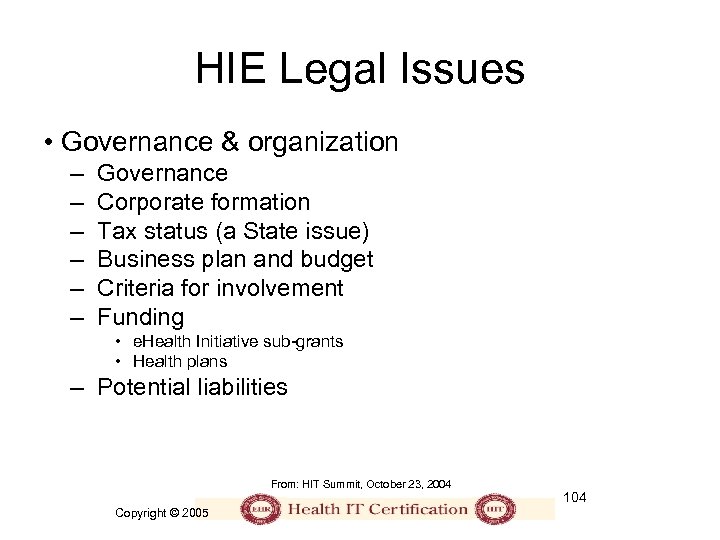 HIE Legal Issues • Governance & organization – – – Governance Corporate formation Tax status (a State issue) Business plan and budget Criteria for involvement Funding • e. Health Initiative sub-grants • Health plans – Potential liabilities From: HIT Summit, October 23, 2004 Copyright © 2005 104
HIE Legal Issues • Governance & organization – – – Governance Corporate formation Tax status (a State issue) Business plan and budget Criteria for involvement Funding • e. Health Initiative sub-grants • Health plans – Potential liabilities From: HIT Summit, October 23, 2004 Copyright © 2005 104
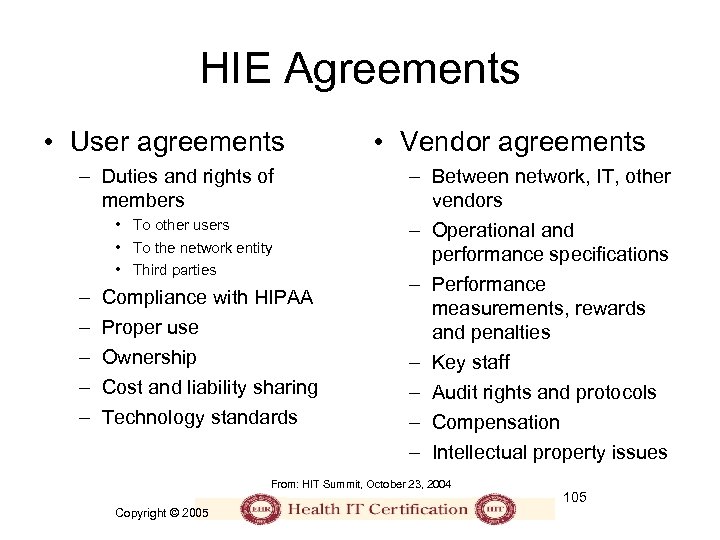 HIE Agreements • User agreements – Duties and rights of members • To other users • To the network entity • Third parties – – – Compliance with HIPAA Proper use Ownership Cost and liability sharing Technology standards • Vendor agreements – Between network, IT, other vendors – Operational and performance specifications – Performance measurements, rewards and penalties – Key staff – Audit rights and protocols – Compensation – Intellectual property issues From: HIT Summit, October 23, 2004 Copyright © 2005 105
HIE Agreements • User agreements – Duties and rights of members • To other users • To the network entity • Third parties – – – Compliance with HIPAA Proper use Ownership Cost and liability sharing Technology standards • Vendor agreements – Between network, IT, other vendors – Operational and performance specifications – Performance measurements, rewards and penalties – Key staff – Audit rights and protocols – Compensation – Intellectual property issues From: HIT Summit, October 23, 2004 Copyright © 2005 105
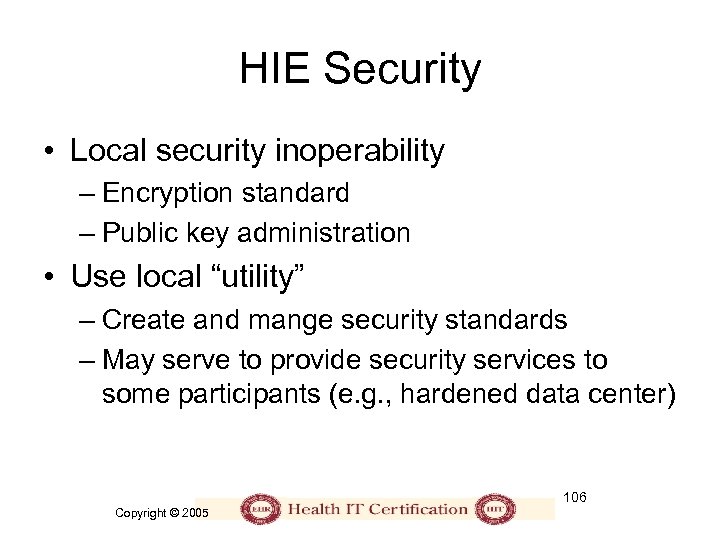 HIE Security • Local security inoperability – Encryption standard – Public key administration • Use local “utility” – Create and mange security standards – May serve to provide security services to some participants (e. g. , hardened data center) 106 Copyright © 2005
HIE Security • Local security inoperability – Encryption standard – Public key administration • Use local “utility” – Create and mange security standards – May serve to provide security services to some participants (e. g. , hardened data center) 106 Copyright © 2005
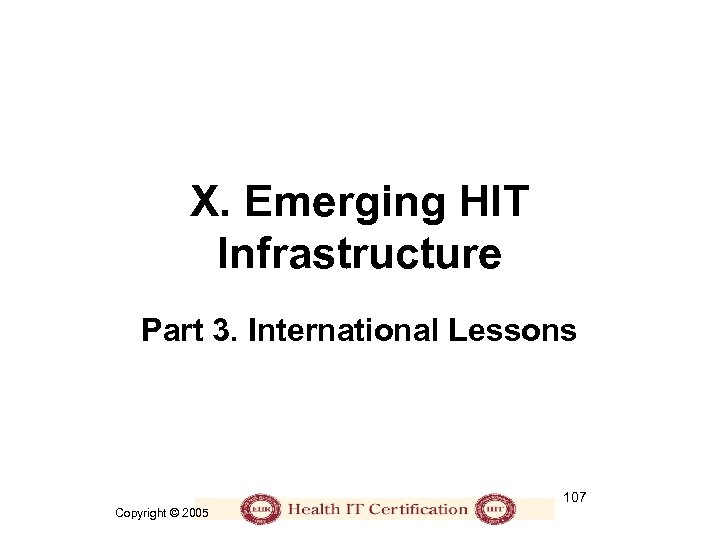 X. Emerging HIT Infrastructure Part 3. International Lessons 107 Copyright © 2005
X. Emerging HIT Infrastructure Part 3. International Lessons 107 Copyright © 2005
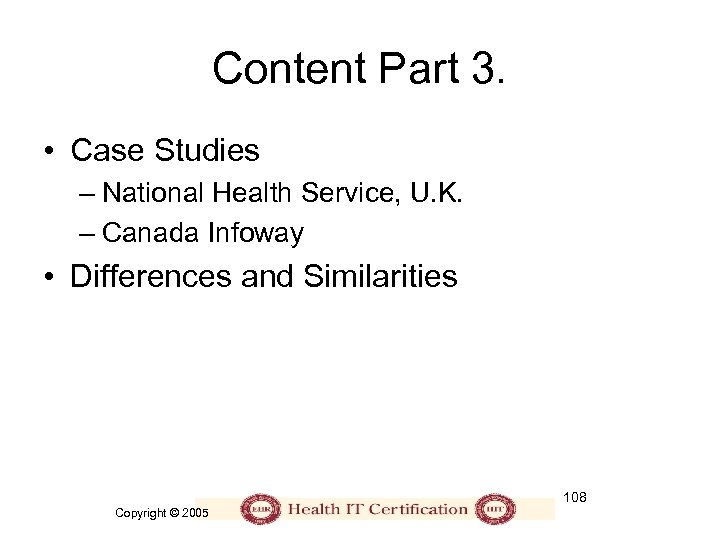 Content Part 3. • Case Studies – National Health Service, U. K. – Canada Infoway • Differences and Similarities 108 Copyright © 2005
Content Part 3. • Case Studies – National Health Service, U. K. – Canada Infoway • Differences and Similarities 108 Copyright © 2005
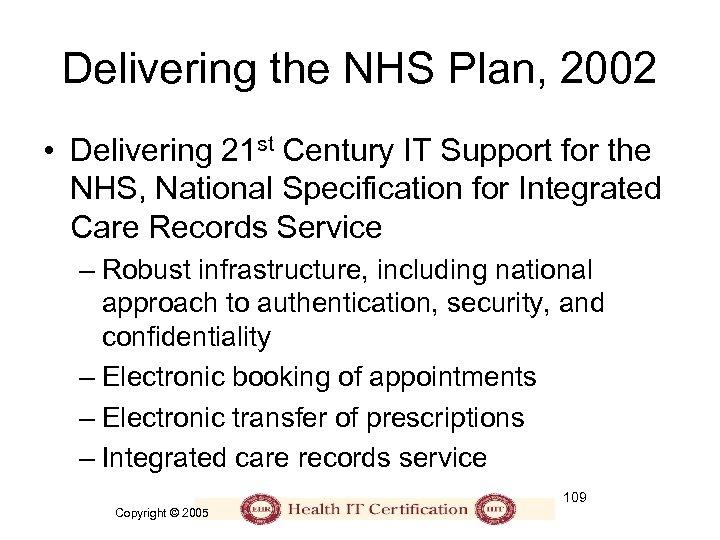 Delivering the NHS Plan, 2002 • Delivering 21 st Century IT Support for the NHS, National Specification for Integrated Care Records Service – Robust infrastructure, including national approach to authentication, security, and confidentiality – Electronic booking of appointments – Electronic transfer of prescriptions – Integrated care records service 109 Copyright © 2005
Delivering the NHS Plan, 2002 • Delivering 21 st Century IT Support for the NHS, National Specification for Integrated Care Records Service – Robust infrastructure, including national approach to authentication, security, and confidentiality – Electronic booking of appointments – Electronic transfer of prescriptions – Integrated care records service 109 Copyright © 2005
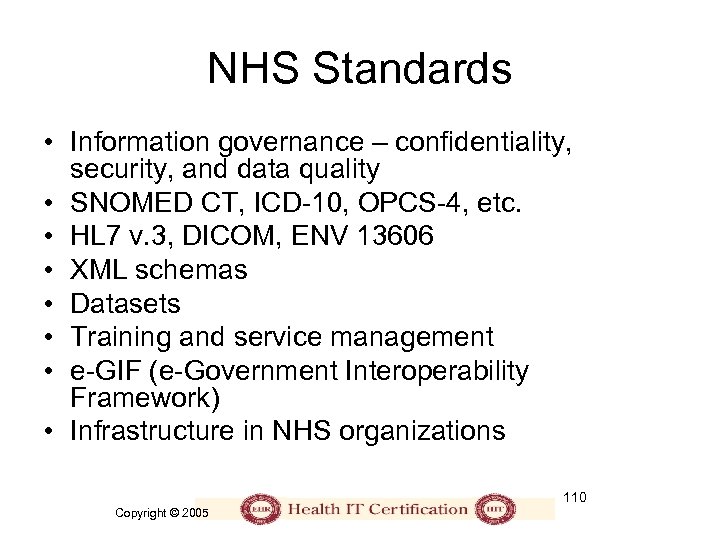 NHS Standards • Information governance – confidentiality, security, and data quality • SNOMED CT, ICD-10, OPCS-4, etc. • HL 7 v. 3, DICOM, ENV 13606 • XML schemas • Datasets • Training and service management • e-GIF (e-Government Interoperability Framework) • Infrastructure in NHS organizations 110 Copyright © 2005
NHS Standards • Information governance – confidentiality, security, and data quality • SNOMED CT, ICD-10, OPCS-4, etc. • HL 7 v. 3, DICOM, ENV 13606 • XML schemas • Datasets • Training and service management • e-GIF (e-Government Interoperability Framework) • Infrastructure in NHS organizations 110 Copyright © 2005
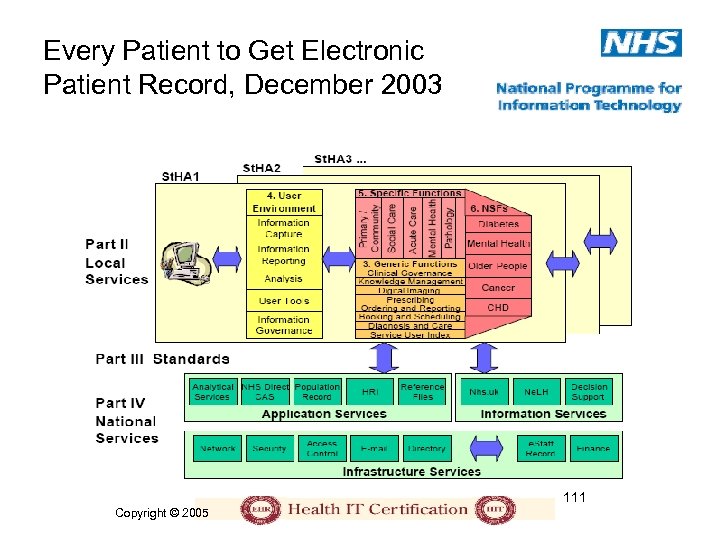 Every Patient to Get Electronic Patient Record, December 2003 111 Copyright © 2005
Every Patient to Get Electronic Patient Record, December 2003 111 Copyright © 2005
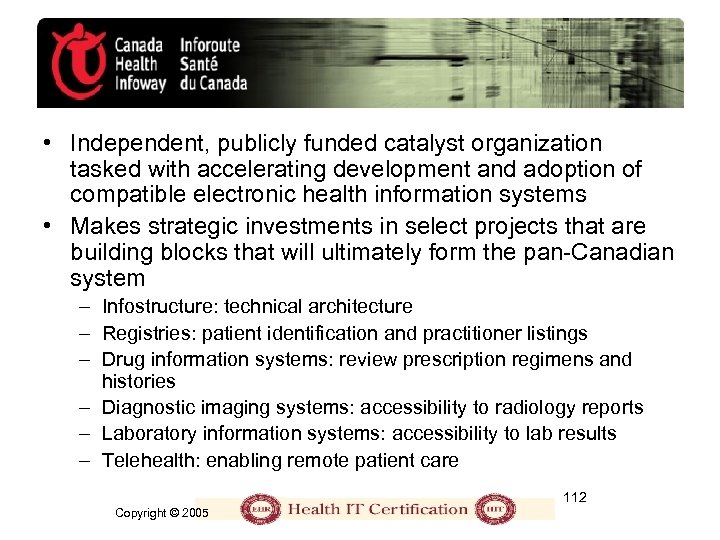 • Independent, publicly funded catalyst organization tasked with accelerating development and adoption of compatible electronic health information systems • Makes strategic investments in select projects that are building blocks that will ultimately form the pan-Canadian system – Infostructure: technical architecture – Registries: patient identification and practitioner listings – Drug information systems: review prescription regimens and histories – Diagnostic imaging systems: accessibility to radiology reports – Laboratory information systems: accessibility to lab results – Telehealth: enabling remote patient care 112 Copyright © 2005
• Independent, publicly funded catalyst organization tasked with accelerating development and adoption of compatible electronic health information systems • Makes strategic investments in select projects that are building blocks that will ultimately form the pan-Canadian system – Infostructure: technical architecture – Registries: patient identification and practitioner listings – Drug information systems: review prescription regimens and histories – Diagnostic imaging systems: accessibility to radiology reports – Laboratory information systems: accessibility to lab results – Telehealth: enabling remote patient care 112 Copyright © 2005
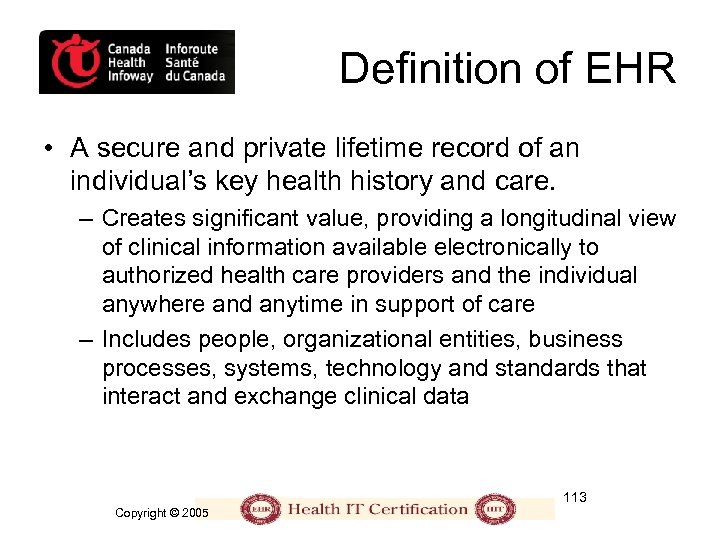 Definition of EHR • A secure and private lifetime record of an individual’s key health history and care. – Creates significant value, providing a longitudinal view of clinical information available electronically to authorized health care providers and the individual anywhere and anytime in support of care – Includes people, organizational entities, business processes, systems, technology and standards that interact and exchange clinical data 113 Copyright © 2005
Definition of EHR • A secure and private lifetime record of an individual’s key health history and care. – Creates significant value, providing a longitudinal view of clinical information available electronically to authorized health care providers and the individual anywhere and anytime in support of care – Includes people, organizational entities, business processes, systems, technology and standards that interact and exchange clinical data 113 Copyright © 2005
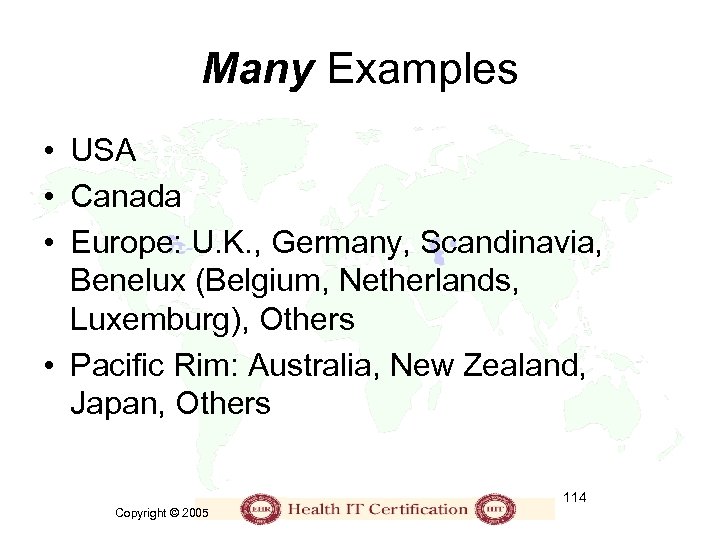 Many Examples • USA • Canada • Europe: U. K. , Germany, Scandinavia, Benelux (Belgium, Netherlands, Luxemburg), Others • Pacific Rim: Australia, New Zealand, Japan, Others 114 Copyright © 2005
Many Examples • USA • Canada • Europe: U. K. , Germany, Scandinavia, Benelux (Belgium, Netherlands, Luxemburg), Others • Pacific Rim: Australia, New Zealand, Japan, Others 114 Copyright © 2005
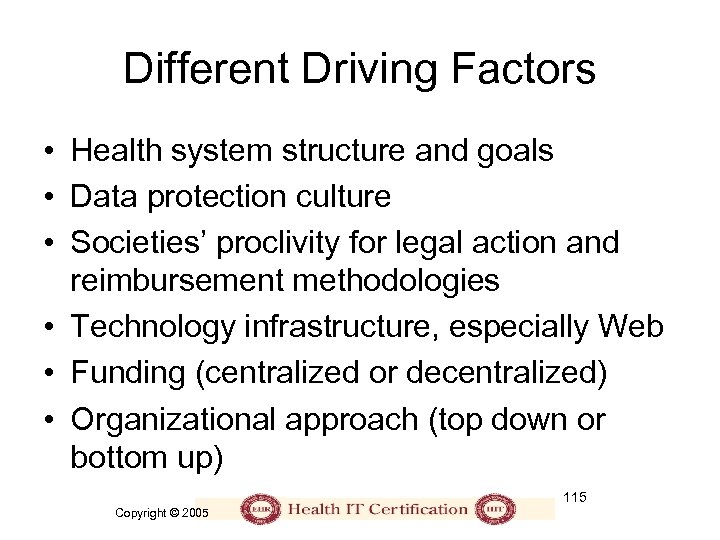 Different Driving Factors • Health system structure and goals • Data protection culture • Societies’ proclivity for legal action and reimbursement methodologies • Technology infrastructure, especially Web • Funding (centralized or decentralized) • Organizational approach (top down or bottom up) 115 Copyright © 2005
Different Driving Factors • Health system structure and goals • Data protection culture • Societies’ proclivity for legal action and reimbursement methodologies • Technology infrastructure, especially Web • Funding (centralized or decentralized) • Organizational approach (top down or bottom up) 115 Copyright © 2005
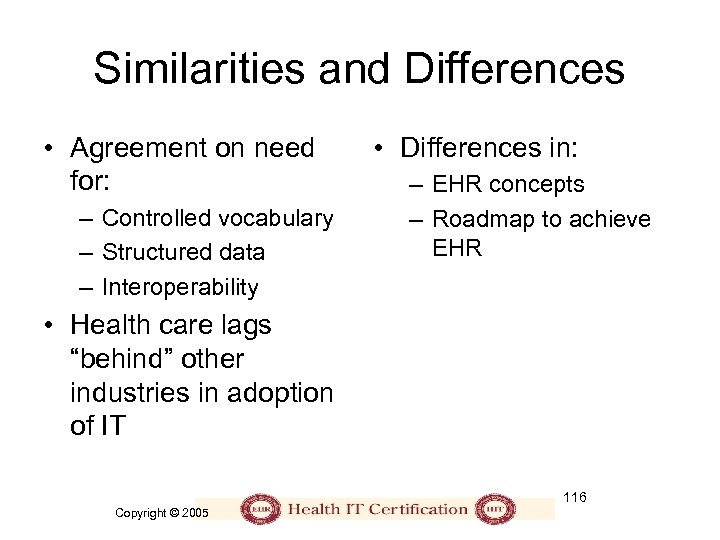 Similarities and Differences • Agreement on need for: – Controlled vocabulary – Structured data – Interoperability • Differences in: – EHR concepts – Roadmap to achieve EHR • Health care lags “behind” other industries in adoption of IT 116 Copyright © 2005
Similarities and Differences • Agreement on need for: – Controlled vocabulary – Structured data – Interoperability • Differences in: – EHR concepts – Roadmap to achieve EHR • Health care lags “behind” other industries in adoption of IT 116 Copyright © 2005
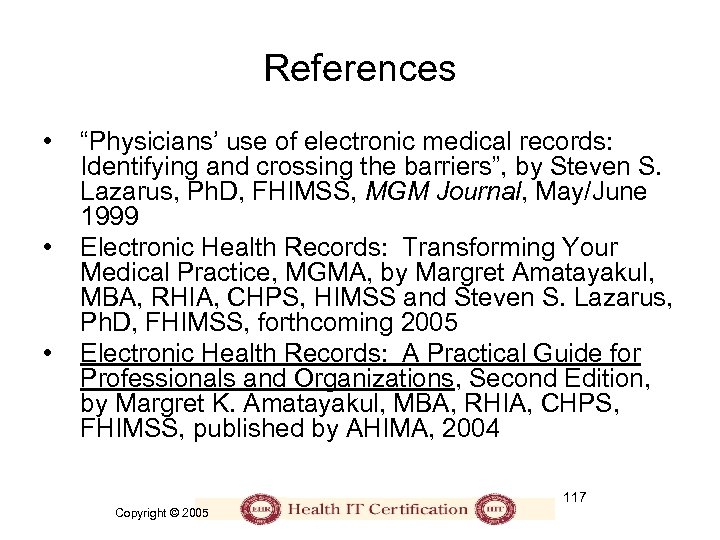 References • • • “Physicians’ use of electronic medical records: Identifying and crossing the barriers”, by Steven S. Lazarus, Ph. D, FHIMSS, MGM Journal, May/June 1999 Electronic Health Records: Transforming Your Medical Practice, MGMA, by Margret Amatayakul, MBA, RHIA, CHPS, HIMSS and Steven S. Lazarus, Ph. D, FHIMSS, forthcoming 2005 Electronic Health Records: A Practical Guide for Professionals and Organizations, Second Edition, by Margret K. Amatayakul, MBA, RHIA, CHPS, FHIMSS, published by AHIMA, 2004 117 Copyright © 2005
References • • • “Physicians’ use of electronic medical records: Identifying and crossing the barriers”, by Steven S. Lazarus, Ph. D, FHIMSS, MGM Journal, May/June 1999 Electronic Health Records: Transforming Your Medical Practice, MGMA, by Margret Amatayakul, MBA, RHIA, CHPS, HIMSS and Steven S. Lazarus, Ph. D, FHIMSS, forthcoming 2005 Electronic Health Records: A Practical Guide for Professionals and Organizations, Second Edition, by Margret K. Amatayakul, MBA, RHIA, CHPS, FHIMSS, published by AHIMA, 2004 117 Copyright © 2005
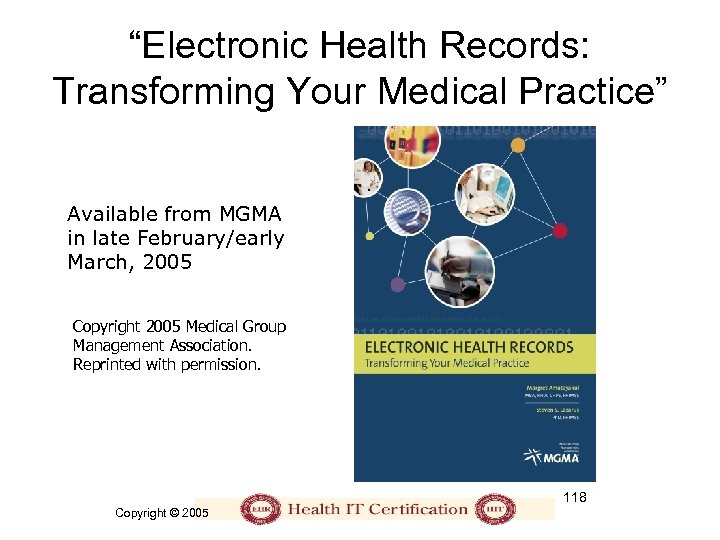 “Electronic Health Records: Transforming Your Medical Practice” Available from MGMA in late February/early March, 2005 Copyright 2005 Medical Group Management Association. Reprinted with permission. 118 Copyright © 2005
“Electronic Health Records: Transforming Your Medical Practice” Available from MGMA in late February/early March, 2005 Copyright 2005 Medical Group Management Association. Reprinted with permission. 118 Copyright © 2005
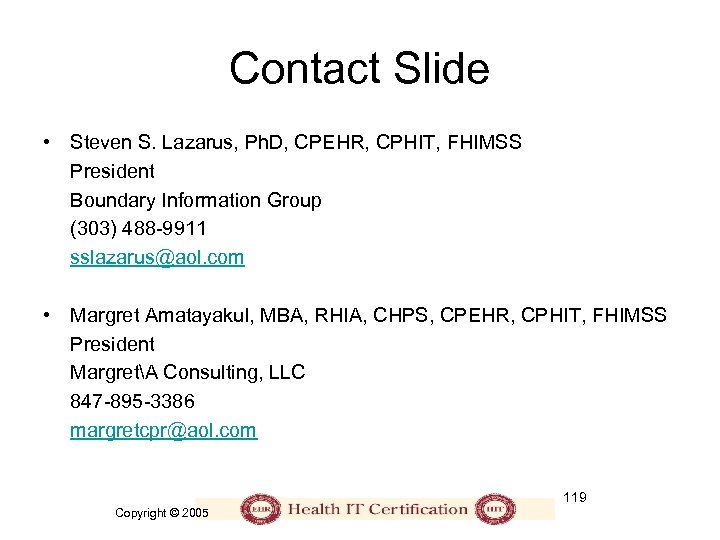 Contact Slide • Steven S. Lazarus, Ph. D, CPEHR, CPHIT, FHIMSS President Boundary Information Group (303) 488 -9911 sslazarus@aol. com • Margret Amatayakul, MBA, RHIA, CHPS, CPEHR, CPHIT, FHIMSS President MargretA Consulting, LLC 847 -895 -3386 margretcpr@aol. com 119 Copyright © 2005
Contact Slide • Steven S. Lazarus, Ph. D, CPEHR, CPHIT, FHIMSS President Boundary Information Group (303) 488 -9911 sslazarus@aol. com • Margret Amatayakul, MBA, RHIA, CHPS, CPEHR, CPHIT, FHIMSS President MargretA Consulting, LLC 847 -895 -3386 margretcpr@aol. com 119 Copyright © 2005
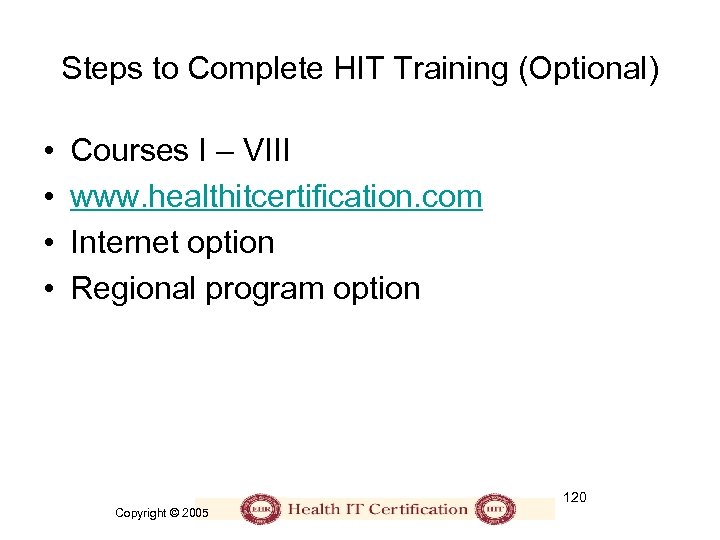 Steps to Complete HIT Training (Optional) • • Courses I – VIII www. healthitcertification. com Internet option Regional program option 120 Copyright © 2005
Steps to Complete HIT Training (Optional) • • Courses I – VIII www. healthitcertification. com Internet option Regional program option 120 Copyright © 2005


